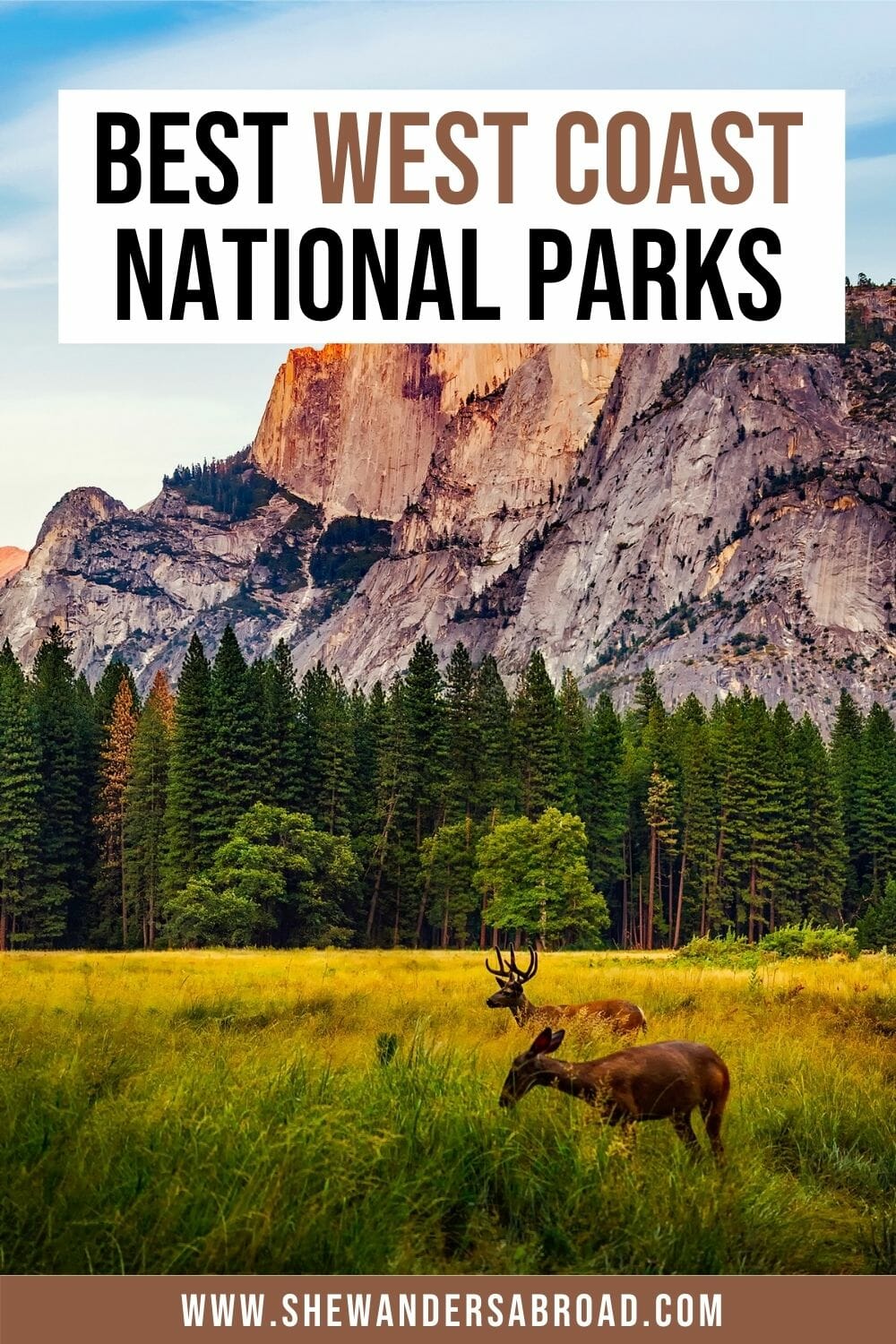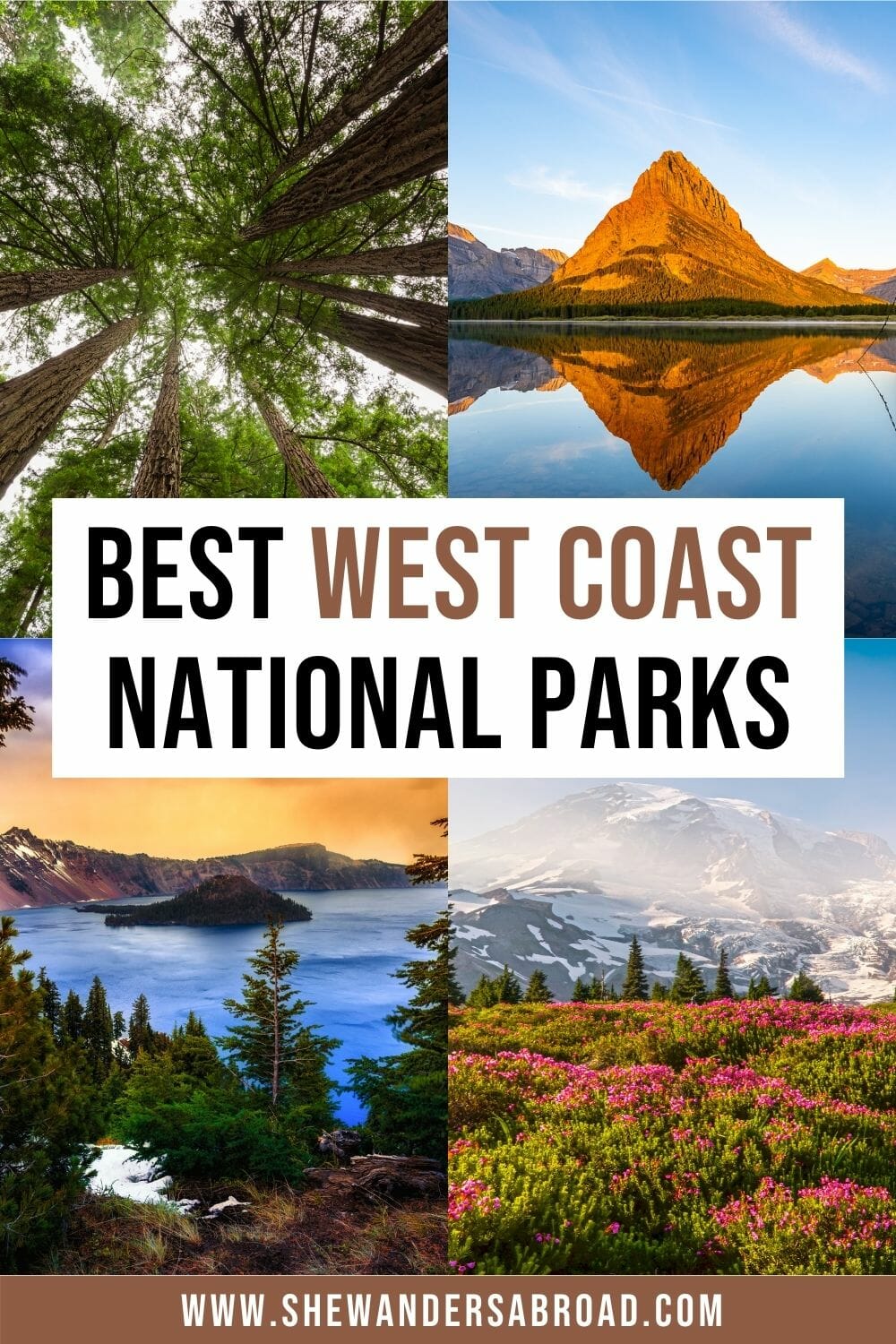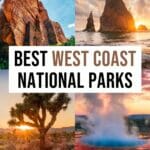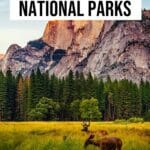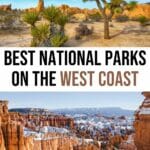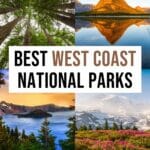If you love spending time outdoors and are looking for some incredible West Coast National Parks to explore, look no further! This list is packed with some of the most beautiful and awe-inspiring parks in the region. So grab your camping gear, hiking boots, and sunscreen – it’s time to start planning your adventure!
*Disclosure: This post contains a few affiliate links, which means I may receive a small commission, at no cost to you, if you make a purchase through my link.*
No time to read now? Pin it for later!
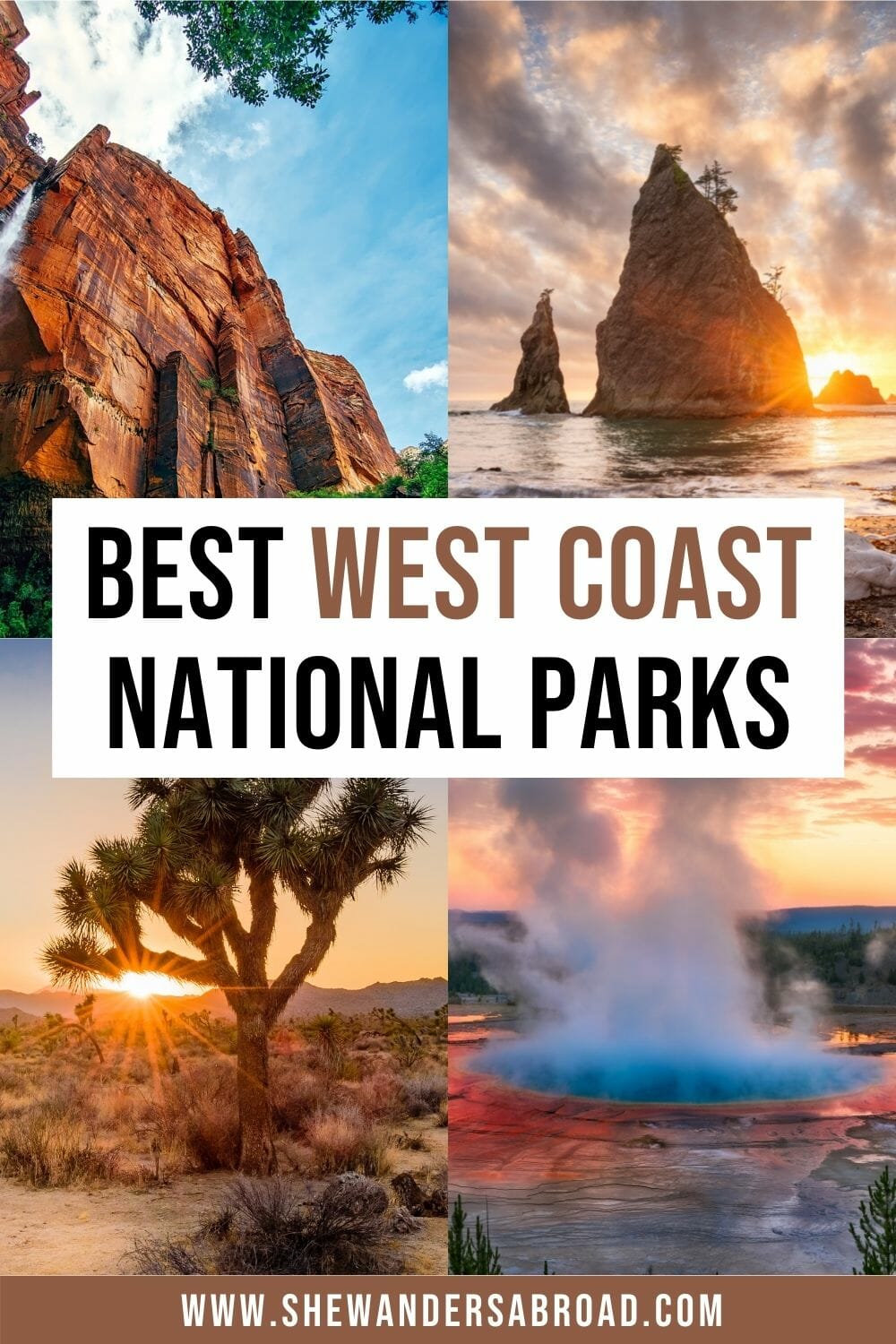
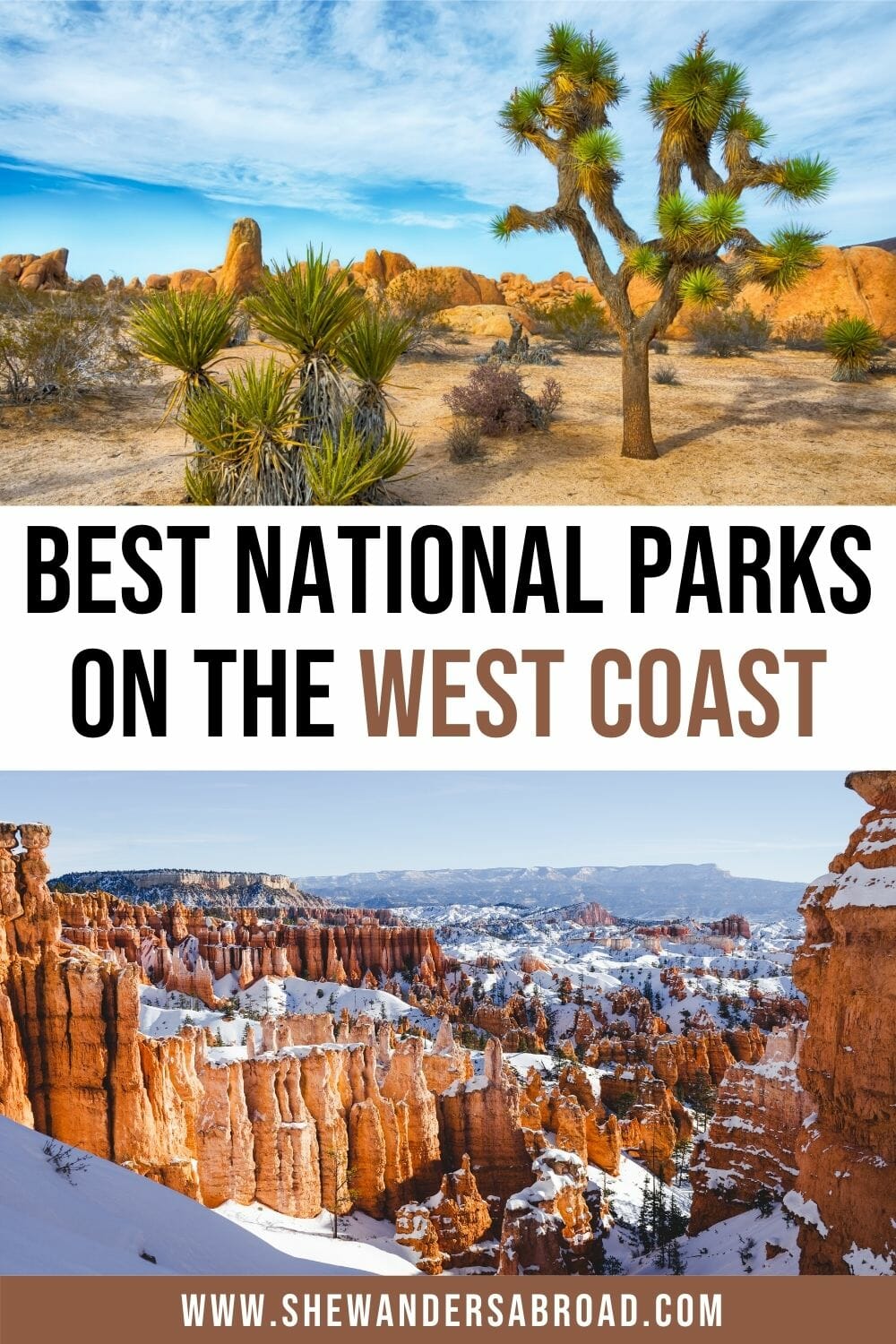
Table of Contents
Tips for Visiting the National Parks on the West Coast
- Entrance fees: West Coast National Parks typically charge a fee of $20-30 per vehicle, which grants access to one private, non-commercial vehicle with up to 15 passengers. In case you’re visiting without a car, passes for motorcycles and individuals are also available. Passes are typically valid for seven consecutive days.
- Entrance fee-free days: National parks can be visited for free on specific days throughout the year, such as the first day of National Park Week and Veterans Day. You can learn more about the free days on the National Park Service website.
- National Park Pass: If you’re planning to visit a few of the parks on this list, it might be worth investing in a National Park Pass. Buying the annual America the Beautiful Pass is the best option, which gives you access to more than 2,000 federal recreation sites, including national parks and national forests. It costs $80 and is valid for 12 months.
- National Park Passport: If you’re looking for a fun way to commemorate your visits to the different parks, consider picking up a National Park Passport. This handy little book is filled with pages for you to stamp with the official National Park Service stamp as you visit each park.
- Leave No Trace: As with any outdoor activity, it’s important to remember the Leave No Trace Principle when visiting national parks. This means leaving the park as you found it – or even better, improving upon it. That includes picking out all of your trash, disposing of human waste properly, and avoiding damaging or disturbing the natural resources.
- Camping: If you’re looking to really get immersed in the park experience, camping is the way to do it! Most of the parks on this list have campgrounds available, and some even have backcountry camping opportunities. Note that reservations are often required, especially during peak season.
- Food and drinks: It’s always important to pack enough food and drinks when venturing into the great outdoors, and this is especially true when visiting national parks. Not only will you need to sustain yourself during your visit, but also most parks have limited or no food service available. So make sure to bring along plenty of snacks, water, and any other supplies you might need.
Now that you’re armed with this information, it’s time to start planning your visit to some of the best West Coast National Parks! Get excited for amazing views, fresh air, and plenty of outdoor adventure.
Best West Coast National Parks You Can’t Miss
The West Coast of the United States is known for its stunning natural beauty and diverse landscape. If you’re looking for a great outdoor adventure, be sure to check out some of the amazing national parks located on this coast.
From the towering Redwoods of California to the rugged peaks of Washington, there’s something for everyone in these parks. So let’s start the list with the best parks located in the coastal states of California, Oregon, and Washington.
1. Joshua Tree National Park, California
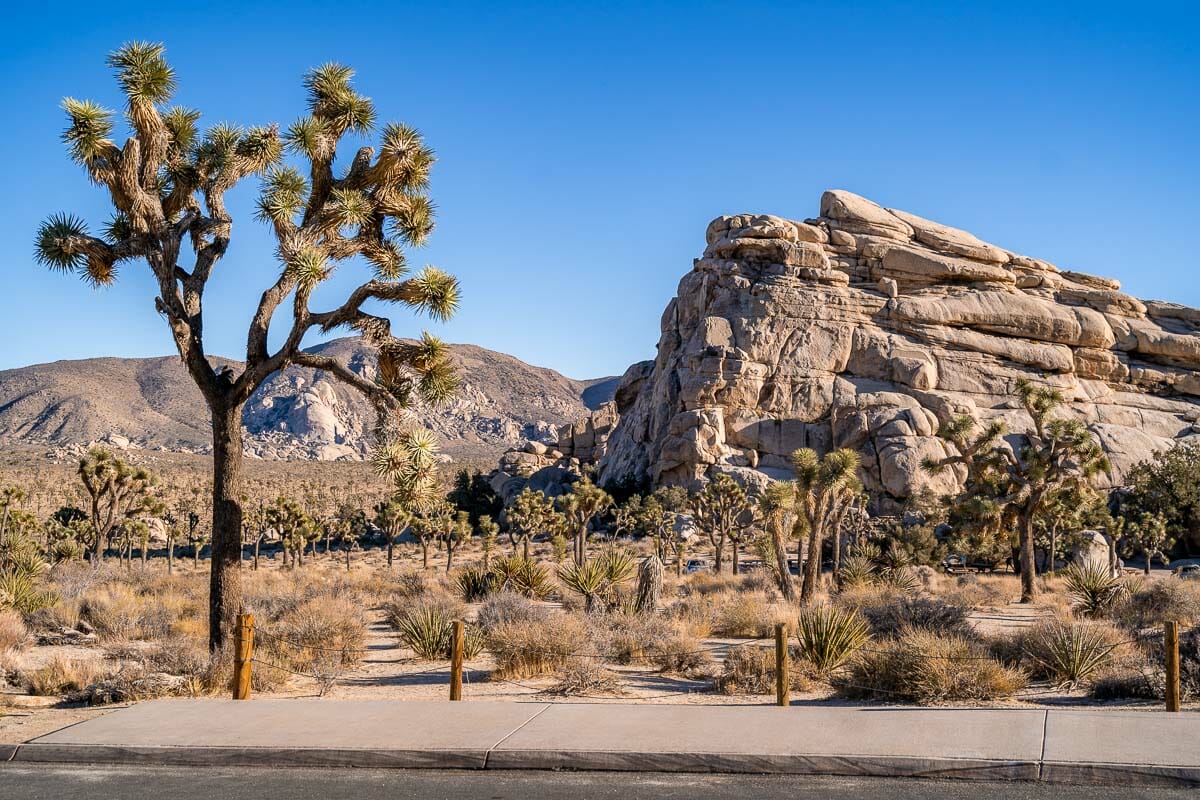
Recommended by Kriszti from She Wanders Abroad
Entrance fee: $30 per vehicle (valid for 7 days)
Best time to visit: Spring and fall
How many days to spend there: 1 day
Highlights: Joshua Trees, Cholla Cactus Garden, Keys View, Hidden Valley
Where to stay: Camp within the park or stay in one of the most unique Joshua Tree cabins
Joshua Tree National Park is located in southeastern California and is best known for the Joshua trees which are unique to this area of the country. The park is about 2 hours from Los Angeles and 3 hours from San Diego.
Joshua Tree National Park was designated a national park in 1994 and at 790,636 acres, it’s one of the smaller parks on this list. Despite its size, the park is full of interesting geological features and a wide variety of plants and animals.
The Joshua trees are a must-see when visiting the park and can be found throughout the park. There’s also a lot of other interesting vegetation including yucca, cholla cactus, ocotillo, and palms. The desert environment is also home to a variety of animals such as coyotes, lizards, and snakes.
If you’re only able to spend one day in Joshua Tree National Park, you will still be able to see the highlights. Make sure to check out Keys View, which offers the best panoramic views in the park. Other highlights include Cholla Cactus Garden, Skull Rock, and Hidden Valley which is a large, open valley with a number of hikes and rock formations.
2. Death Valley National Park, California
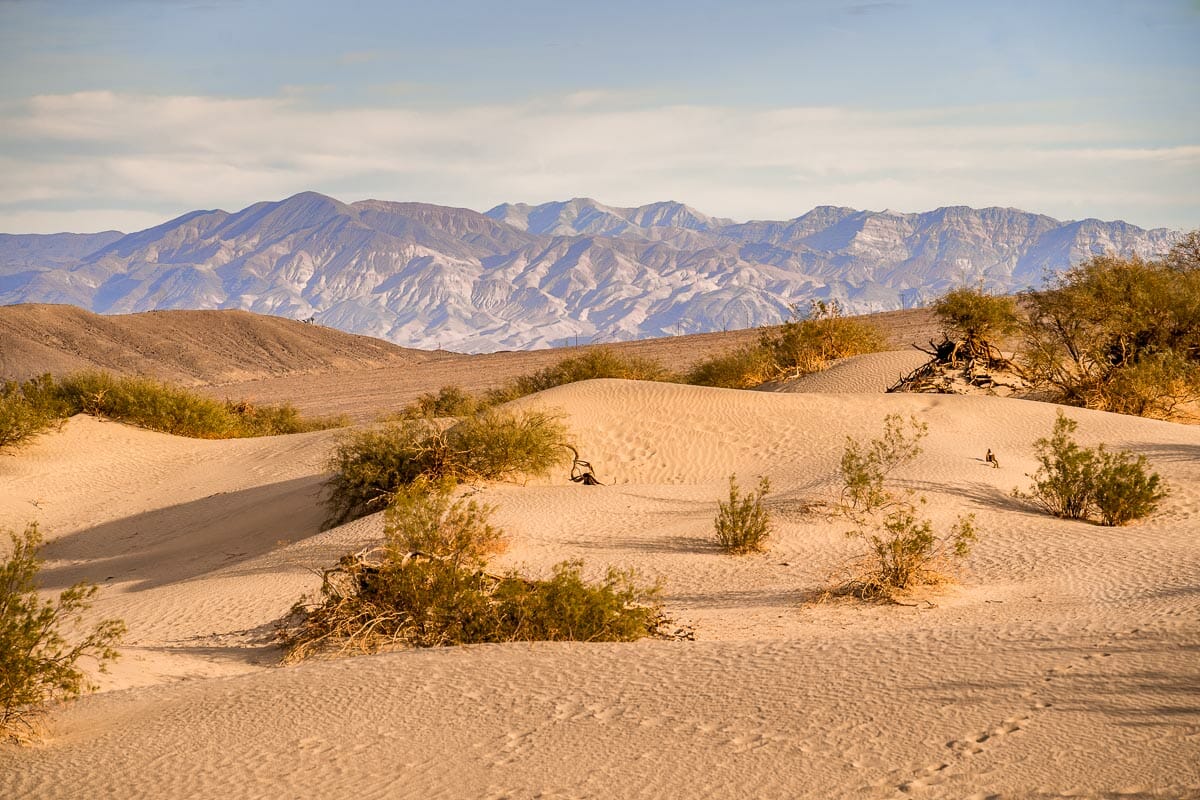
Recommended by Kriszti from She Wanders Abroad
Entrance fee: $30 per vehicle (valid for 7 days)
Best time to visit: November to March
How many days to spend there: 1-2 days
Highlights: Badwater Basin, Mesquite Flat Sand Dunes, Zabriskie Point, Artists Palette
Where to stay: Camp within the park or stay in a hotel in Furnace Creek, Beatty, or Pahrump
Located in southeastern California, Death Valley National Park is the largest national park south of Alaska. It’s also the lowest point of North America and holds the record for the hottest air temperature ever recorded, which makes it one of the most unique West Coast National Parks to visit.
Death Valley gets its name from the extreme temperatures that can be found within the park. The record high temperature was 134.1°F (56.7 °C )! Despite the extreme temperatures, the park is a popular destination for visitors from all over the world. Just make sure to avoid the summer months altogether!
There are a number of things to see and do in the park and it’s possible to visit all of the best places in just one day in Death Valley National Park. It’s also one of the best day trips from Las Vegas, in case you don’t want to stay in the nearby towns.
The main attractions are found near the visitor center which is located in the Furnace Creek area of the park. This is where you’ll find Badwater Basin, the lowest point in North America, and Dante’s View, which offers some of the best views in the park.
Zabriskie Point and Golden Canyon are also popular destinations and offer great views of the surrounding landscape. You also can’t miss Artist Palette which is a colorful landscape of hills and canyons.
3. Sequoia National Park, California
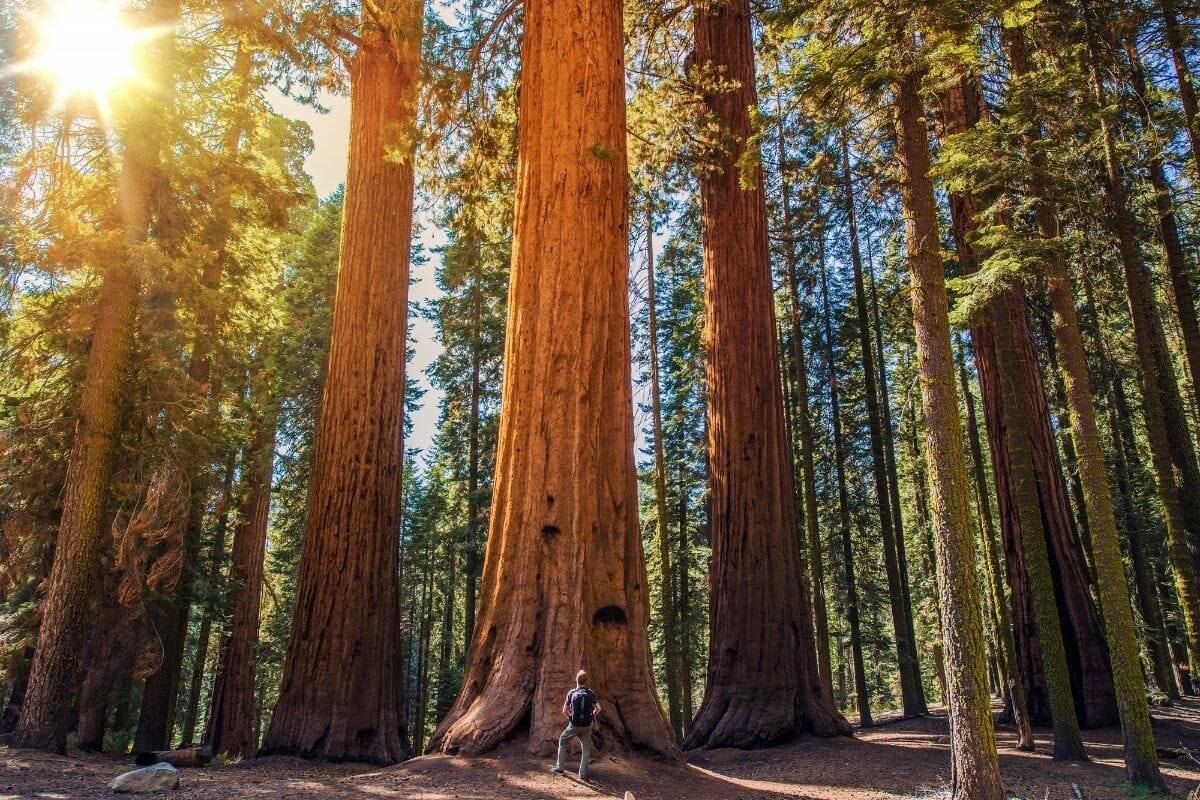
Recommended by Mary from Be Right Back by Mary
Entrance fee: $35 per vehicle (valid for 7 days for both Sequoia and King’s Canyon National Park)
Best time to visit: June to September
How many days to spend there: 1-2 days
Highlights: Trail of 100 Giants, General Sherman Tree
Where to stay: It is possible to stay in Visalia which is the closest city to the park
Sequoia National Park is located near the town of Three Rivers. Sequoia National Park is close to two airports: Fresno Yosemite International airport and Visalia Municipal Airport, making it easily accessible for travelers.
Although the park is open every day of the year, summer offers the best temperatures and sunny skies almost every day. Visiting during winter will most likely require snow chains and snow tires and warmer equipment.
Sequoia National Park is known for being home to some of the biggest sequoia trees in the world, including the General Sherman Tree which is the largest tree by volume in the world. The Giant Forest features 8,000 trees including five of the ten biggest trees in the world as well.
From the valley views to driving through giant Sequoia trees, there are lots of things to do in Sequoia. It is possible to see the highlights of the park in one day, which makes Sequoia Park the perfect addition to your West Coast road trip.
However, you can easily spend several days exploring the park especially if you enjoy hiking or swimming in the cool mountain pools!
Although Sequoia Park is best explored by car, a shuttle is also available from Visalia for those who are without a car or cannot drive.
4. Kings Canyon National Park, California
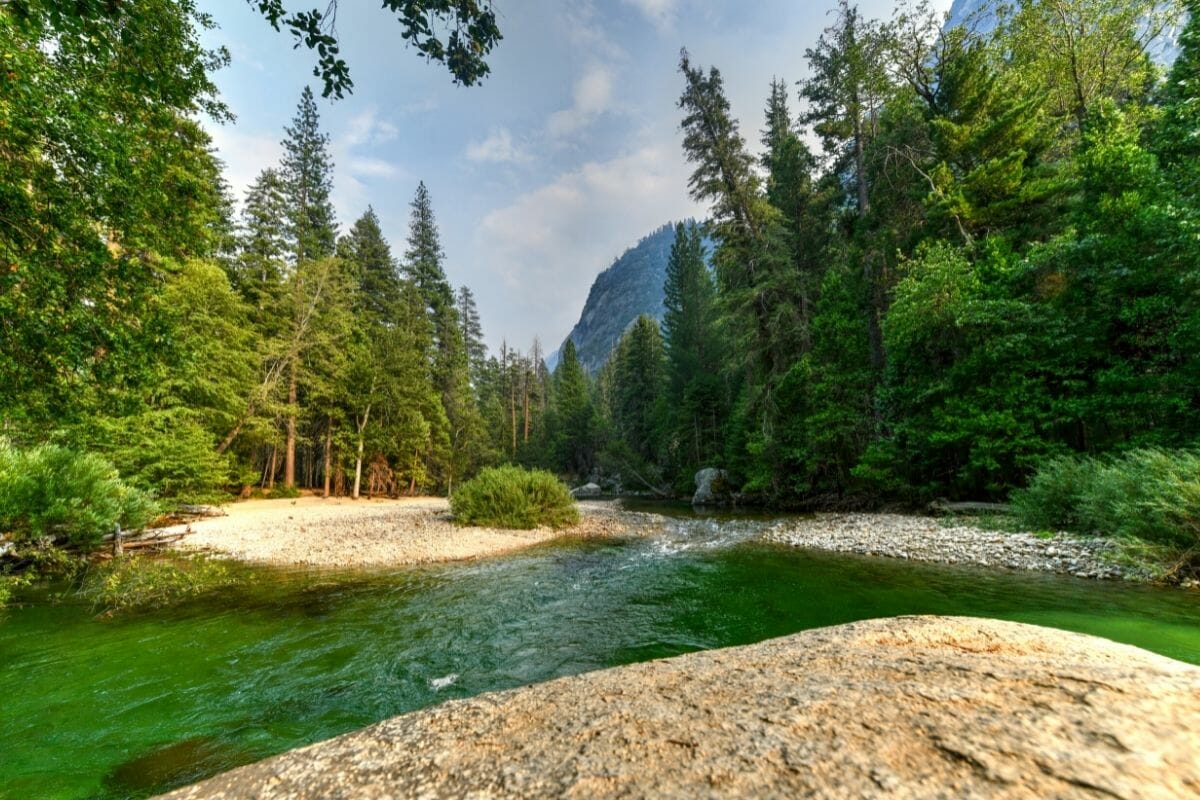
Recommended by Chelsey from Chelsey Explores
Entrance fee: $35 per vehicle (valid for 7 days for both Sequoia and King’s Canyon National Park)
Best time to visit: Summer or fall
How many days to spend there: 1-2 days
Highlights: Muir Rock, Rae Lake Loop
Where to stay: Comfort Inn & Suites Sequoia Kings Canyon is a great option (5 miles from the park’s entrance)
Sequoia and King’s Canyon National Parks are located side by side in California’s Sierra Nevada Mountains and they offer countless activities to be had for any nature lover.
This national park makes a great destination for just about anyone because you can cater your itinerary based on your interests, whether that’s hiking, kid-friendly activities, or enjoying the variety of other things the parks have to offer.
A majority of the best activities can easily be done over a weekend but if you are in no rush or are looking to tackle some longer hikes you could easily extend your stay by up to a week.
Even if you aren’t an early riser viewing Moro Rock during sunrise might be able to get you out from under your covers. It’s only a 20-25 minute climb up a long stairway so you definitely don’t need to be a skilled hiker to enjoy the 360-degree views of the valley.
Another thing to add during one of your mornings before it gets too crowded is the Big Trees Trails to see the Sequoia trees! It’s an easy 0.75 miles loop. The most touristy but must-visit stop inside Sequoia will be visiting General Sherman Tree. If you didn’t know it’s the largest tree by volume in the world!
If you’re looking to cool off Muir Rock is the perfect place to do so. Partake in an 8 ft jump off of the rock if you dare!
As far as hiking goes Tokopah Valley Trail is a moderate 4-mile out and back hike that will lead you to the 1,000 ft Tokopah Falls. For the advanced hiker, Rae Lake Loop is for you. You’ll spend 5 days covering 40 miles to see views of canyons, lakes, waterfalls, and mountains.
5. Yosemite National Park, California
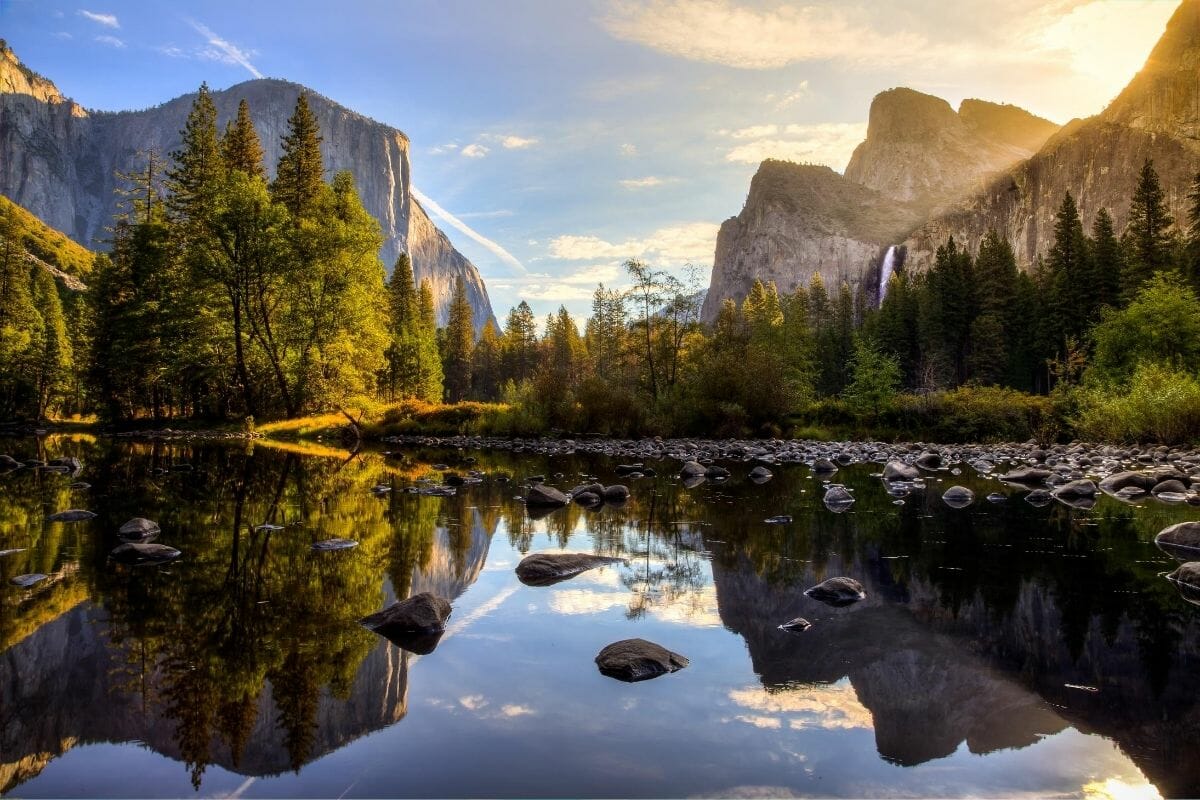
Recommended by Kriszti from She Wanders Abroad
Entrance fee: $35 per vehicle (valid for 3 days from May to September or 7 days in other months)
Best time to visit: May and September
How many days to spend there: 2-3 days
Highlights: Half Dome, Yosemite Falls, El Capitan, Glacier Point
Where to stay: There are 13 campgrounds within the park or you can stay in one of the nearby towns
Yosemite National Park is one of the most popular national parks on the West Coast and for good reason. The park is located in the Sierra Nevada mountains of California and covers more than 1,200 square miles. It’s best known for its impressive granite cliffs, waterfalls, and sequoia forests.
The park was designated a national park in 1890 and at 748,436 acres, it’s the third largest park in California. Yosemite is a popular destination for hikers, climbers, and photographers and can be enjoyed by visitors of all ages.
The main attractions in Yosemite are found near the Valley and can easily be seen in just a few days. Half Dome is one of the most popular hikes in the park and can be reached via a 15-mile long trail from the valley floor. It’s important to note that you have to obtain a permit for hiking Half Dome.
Yosemite Falls is another popular attraction and is one of the tallest waterfalls in North America. El Capitan is a massive granite cliff that is popular with climbers and Glacier Point offers some of the best views in Yosemite National Park.
6. Channel Islands National Park, California
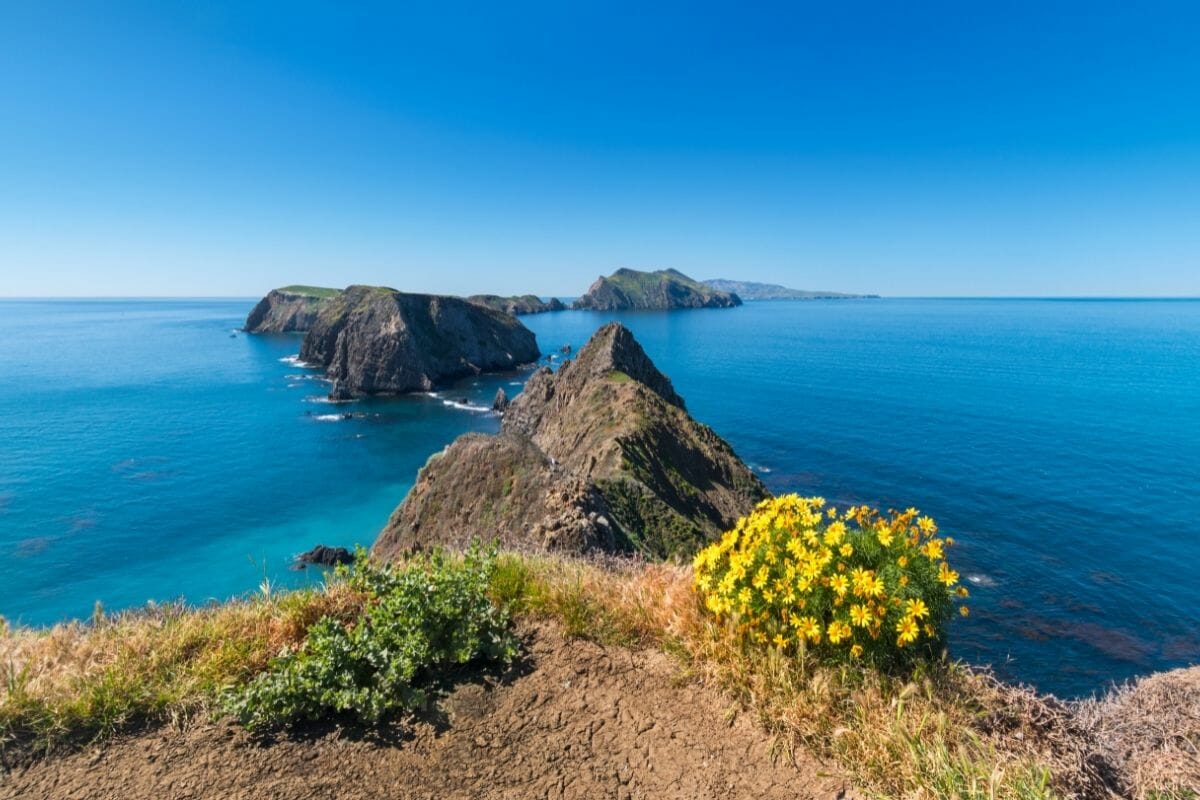
Recommended by Michelle from The Wandering Queen
Entrance fee: No entrance fee
Best time to visit: Summer
How many days to spend there: 1 day
Highlights: Potato Harbor hike, snorkeling, kayaking
Where to stay: There is no hotel on the island; however, you can get a permit to camp on the island.
One of the most secluded and uncrowded national parks on the West Coast is Channel Islands National Park.
This national park is located near Ventura, about an hour and a half northwest of Los Angeles. It comprises four islands, and it only has around 30,000 visitors per year which makes it a great park to get away from the crowds.
To get to the island, you need to ride on a boat and purchase a ticket from Island Packers. Santa Cruz is the best island to visit for the day as it has the most activities and is the largest most popular island.
The boat ride to the Channel Islands is pretty impressive as there is a chance of seeing dolphins and other wildlife. Once you are on the island, you can go sea kayaking, snorkeling, or hiking.
There are many trails on the island that are phenomenal. Just remember to come back in time for the return boat ride as there are no hotels on the island.
7. Pinnacles National Park, California
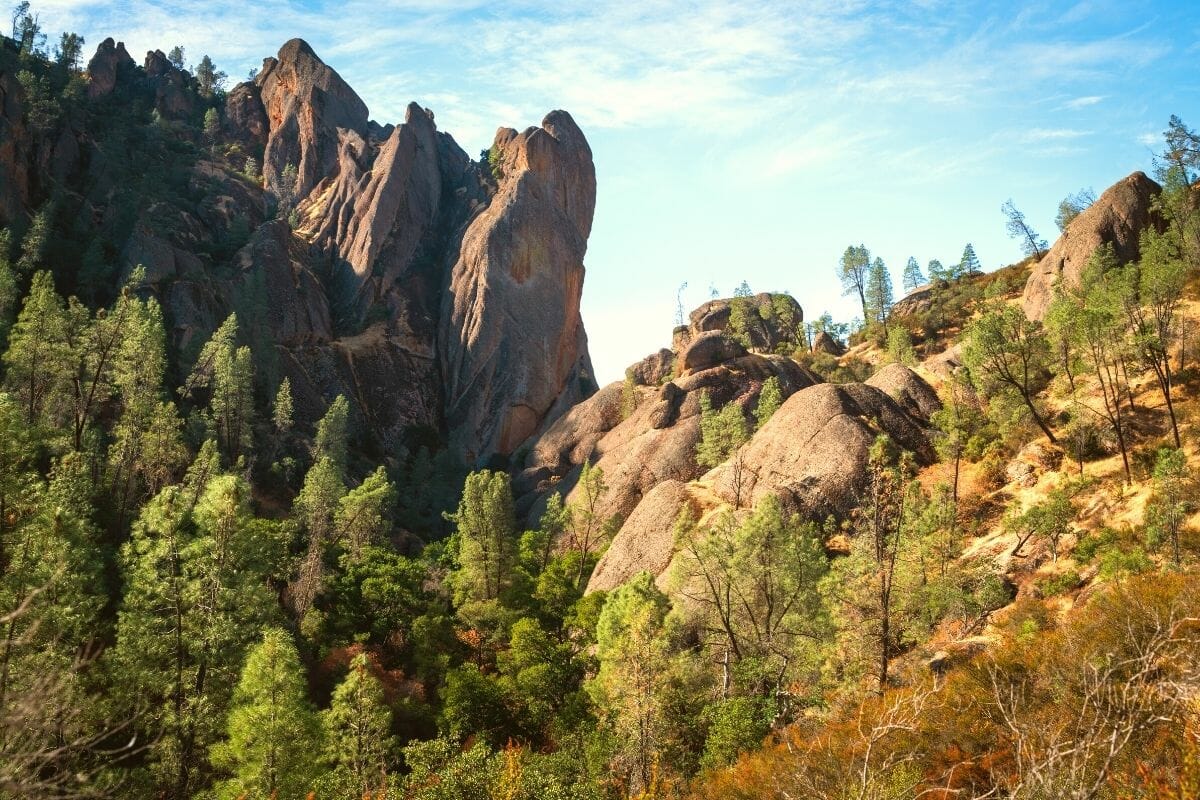
Recommended by Rasika from Bae Area and Beyond
Entrance fee: $30 per vehicle (valid for 7 days)
Best time to visit: March and October
How many days to spend here: 2-3 days
Highlights: Bear Gulch Cave, Balconies Cave, Bear Gulch Reservoir
Where to stay: Inn at Pinnacles
Pinnacles National Park is a relatively small national park located in central California, an hour and a half drive east of San Jose.
This park doesn’t get as much attention as bigger national parks that are much more well-known across the entire country. Despite being a lesser-known national park, Pinnacles is actually one of the most geologically unique and beautiful national parks on the West Coast.
Plus the park also protects a vast array of wildlife including badgers, bobcats, and mountain lions. But its main attraction is the Bear Gulch Cave that’s entirely open during the last week of March and October.
There are also over 30 miles of hiking trails that take you through unique rock formations and rare flora that have been in the park for years, so there is no shortage of things to do in Pinnacles National Park.
The park has two sections – the east side and west side that aren’t connected to each other. Because of that, it’s recommended to spend at least 2 days exploring the best features of both sides of the park.
8. Lassen Volcanic National Park, California
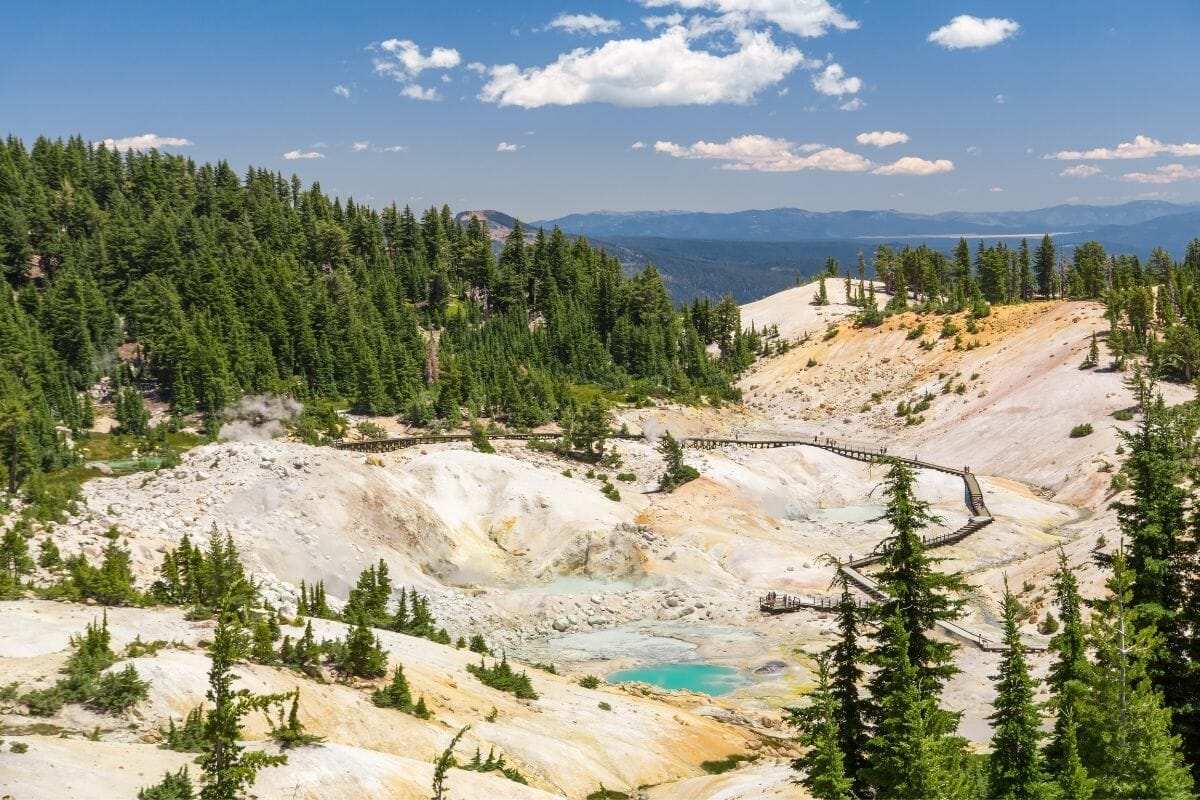
Recommended by Priyadarshini from Glorious Sunrise
Entrance fee: $30 in summer, $10 in winter (valid for 7 days)
Best time to visit: Spring and summer
How many days to spend there: 2 days
Highlights: Scenic Highway drive, Mud Pots, Geothermal areas, Lassen Peak
Where to stay: Drakesbad Guest Ranch inside the park, or the nearby town of Redding
Located in Northern California, near the town of Redding, Lassen Volcanic Park is nature’s delight and definitely one of the most beautiful West Coast national parks.
The park’s only lodging option is Drakesbad Guest Ranch. But don’t fret if you can’t find reservations there. The town of Redding is very close and you can stay there for a super quick drive to Lassen Volcanic Park.
You can enjoy the multitude of gorgeous wildflowers in the park’s spacious meadows, spot wildlife, visit Sulphur Works to see the boiling mud pots, and learn more about their formation. With the area names like Bumpass Hell, Devil’s Kitchen, you can guess that the whole park has interesting features.
To cover most of the things to see, you will need at least two days. Try to find a camping reservation inside the park around one of its lakes to enjoy an authentic Lassen stay. Manzanita lake is the best. Don’t forget to carry a pair of binoculars.
Lassen Park is one of the best areas with dark skies ideal for stargazing. Download the audio tour from the NPS website for an audio tour of the scenic 30-mile highway in the park.
After the 2021 Dixie Fire, some areas have been closed off for hiking, but you can still enjoy the rest of the vast park.
9. Redwood National Park, California
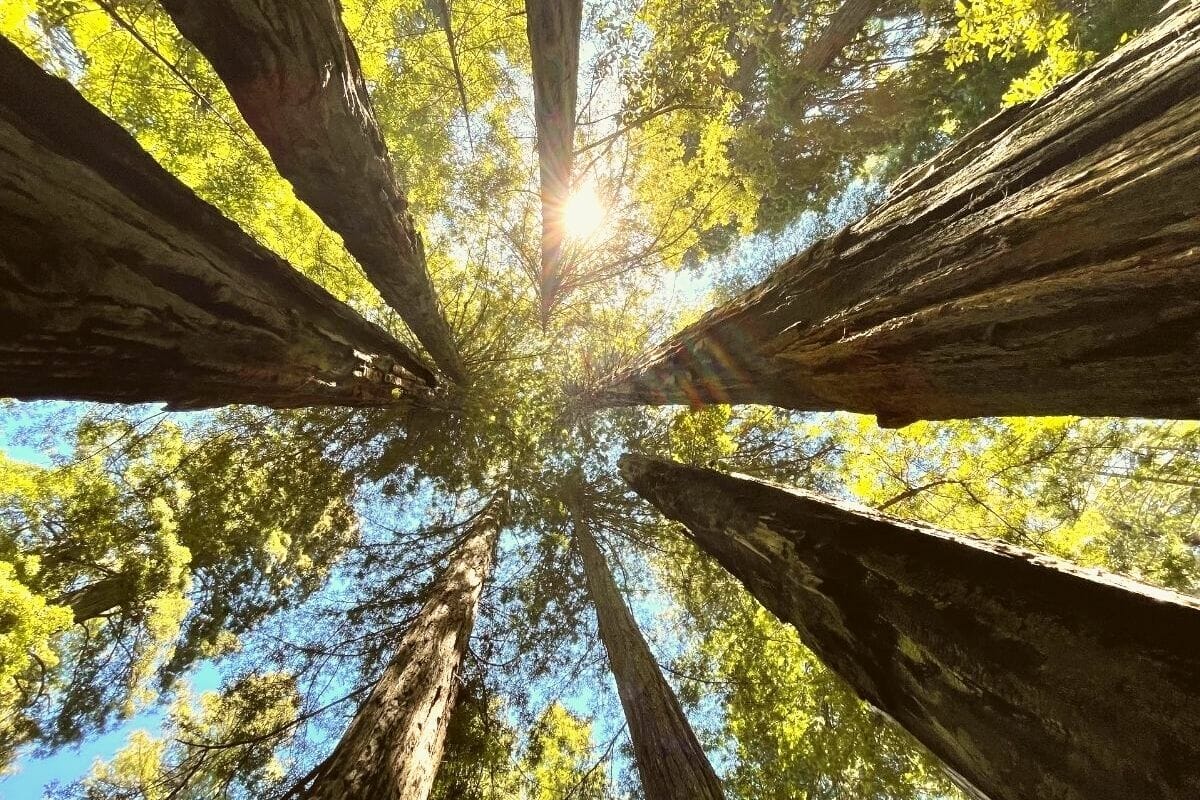
Recommended by Kassidy from Kassidy’s Journey
Entrance fee: No fee, but connected state parks charge $5 for day use
Best time to visit: Summer (June-September)
How many days to spend there: 1-2 days
Highlights: Old-growth redwood trees and coastal views
Where to stay: There are 8 campgrounds within the park. View Crest Lodge is a great choice for accommodations.
Redwoods National Park is found in northern California, just below the border of Oregon. It’s a unique place, with ancient redwood trees covering the forest floor, right next to the Pacific Ocean.
The park is in connection with 3 California state parks, which together protect almost 40,000 acres of the old redwood trees. Because of how large the area is, this national park is great for visitors who prefer less populated areas and love to be immersed in the wilderness.
Two of the best hiking trails within Redwoods National Park are the Lady Bird Johnson Grove trail and Fern Canyon. Both of these are easy and will give you some of the best views of the park.
Driving the Newton B. Drury Scenic Parkway will allow you to get up close and personal with the redwoods. Along the coast, be sure to stop at Crescent Beach and Klamath River Overlooks.
Roosevelt elk call Redwoods National Park home, so be sure to keep an eye out for them as you make your way through the park.
Redwoods National Park is a great place to visit any time of the year, but it’s particularly great in the summer months. The weather is warm and the sun will be out.
You could spend many days exploring Redwoods National Park because there are so many great things to do. It’s recommended to spend at least 1 to 2 days there.
Redwoods National Park in California truly is a unique and wonderful West Coast national park to visit.
10. Crater Lake National Park, Oregon
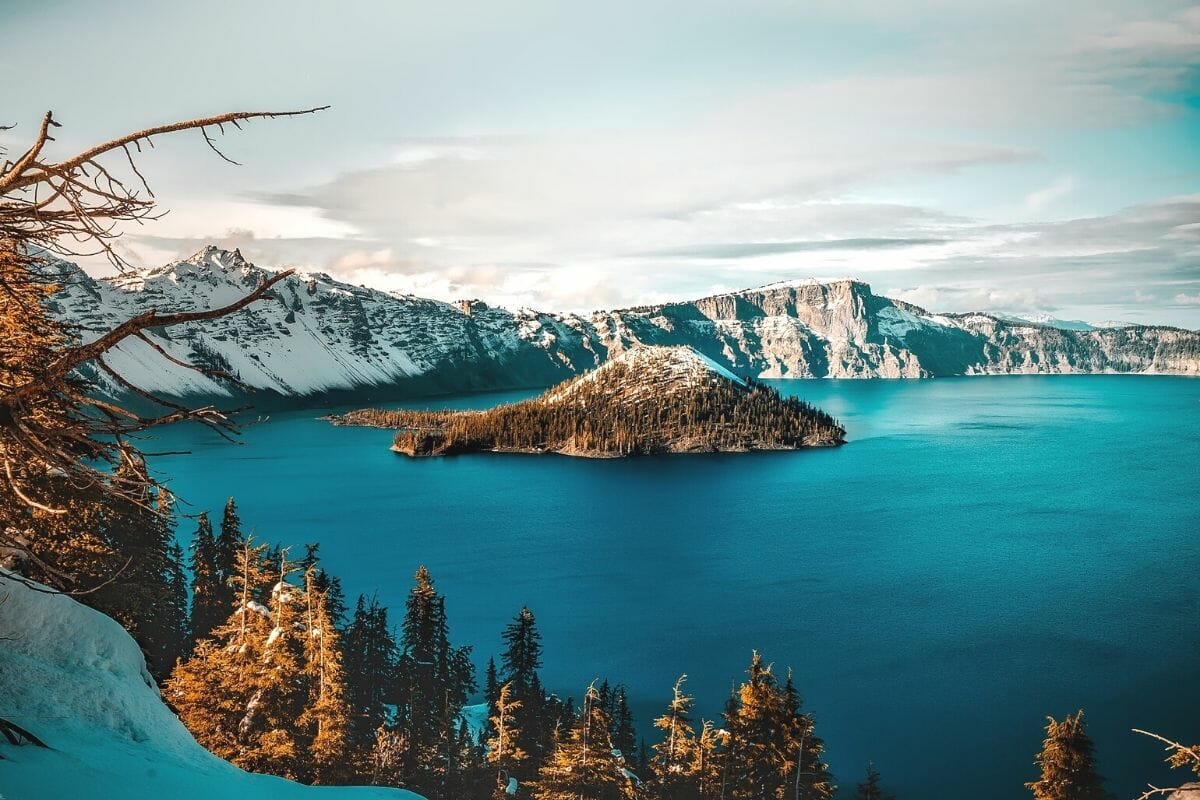
Recommended by Theresa from The Local Tourist
Entrance fee: $30 in the summer or $20 in the winter per vehicle (valid for 7 days)
Best time to visit: July, August, and September
How many days to spend there: 2 days
Highlights: To see one of the world’s deepest, clearest, and bluest lakes.
Where to stay: Crater Lake Lodge or The Cabins at Mazama Village (the only two lodging options in the park)
Crater Lake National Park is located near Bend, Oregon, in the southern part of the state. The lake itself is inside what was once a volcano, and it’s the deepest lake in the United States. It’s also one of the bluest lakes you’ll ever see, making it one of the most unique West Coast national parks!
You’ll find more things to do in Crater Lake National Park than just staring into its depths, however. There are 90 miles of hiking trails and a 33-mile Rim Drive that circles the crater.
During the summer, you can take a boat tour to the island in the middle of the crater, but be aware that you’ll have to hike down – and back up – 700 feet to get to the dock. A less strenuous way to experience the park is to take a trolley tour.
If you’ve only got a day, you can take the trolley tour, drive the rim, and hike some of the trails. It’s better if you’ve got two days so you can see more of the park.
If you’re visiting before July or after September, many of the roads and services may be closed, so summer really is the best time to visit.
11. Mount Rainier National Park, Washington
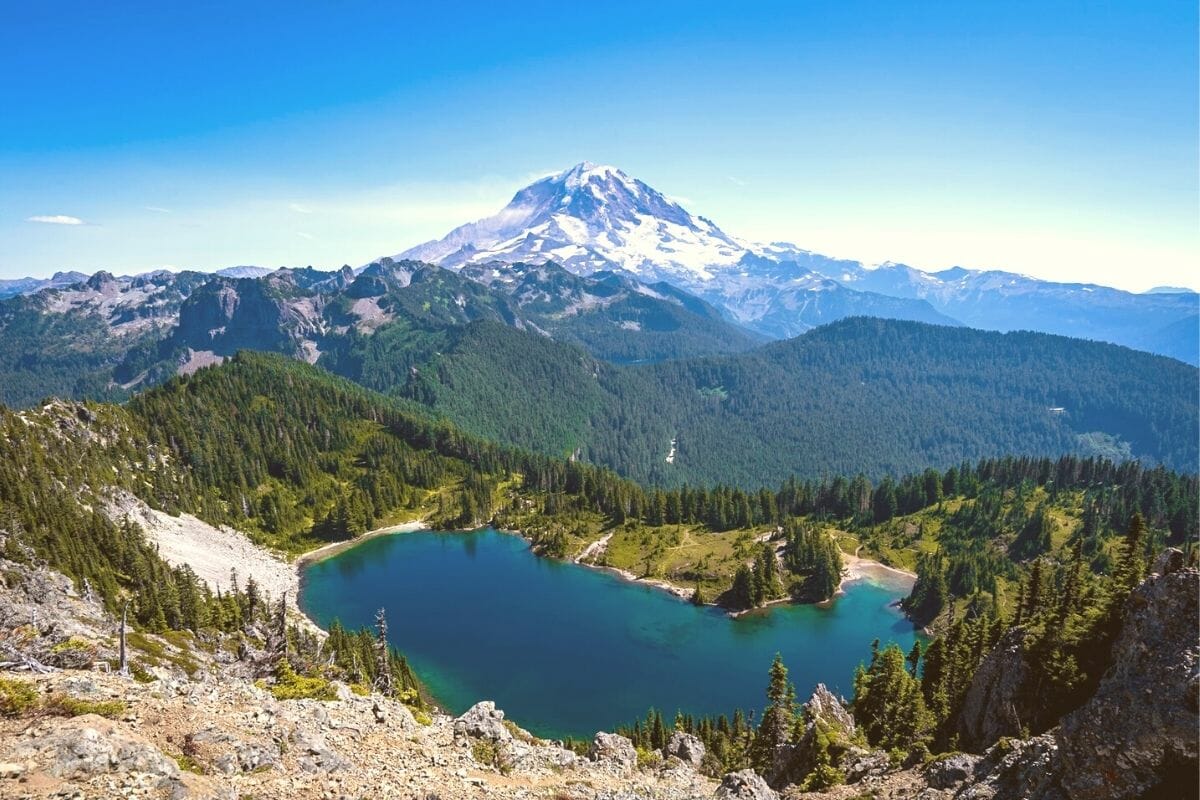
Recommended by Jessica from Uprooted Traveler
Entrance fee: $30 per vehicle (valid for 7 days)
Best time to visit: July through early October
How much time to spend there: 4 days
Highlights: Fremont Lookout and the water features (Reflection, Mowich, or Tipsoo Lakes)
Where to stay: National Park Inn or Paradise Inn inside the park, or the towns of Ashford, Longmire, or Greenwater
Mount Rainier, located in Washington, is home to the state’s tallest mountain, as well as abundant wildlife, lush forests, and gorgeous waterfalls.
Given the mountain’s towering elevation (14,411 feet!), the park receives heavy snow in the winter, with most of its roads inaccessible. Come June, however, the snow starts to melt and technicolor wildflowers emerge along its valleys.
Throughout the summer months, Mount Rainier has some of the most scenic alpine views and best hiking opportunities in the whole country.
Check out the Skyline Trail, which takes you up close and personal to the mountain itself; the Comet Falls Trail, which leads you to a breathtaking 380-foot cascade; and the Tolmie Peak Fire Lookout, providing panoramic views of a turquoise lake and, of course, the eponymous mountain.
Other highlights in the park include the historic fire lookouts, like the Fremont Lookout, which offers spectacular views of Mount Rainier and the surrounding Cascades; the beautiful water features, like Reflection, Mowich, or Tipsoo Lakes; and wildflowers in the summer and amazing fall foliage in autumn in the park’s Paradise section.
If you’re not keen on hiking, there are plenty of low-impact activities to enjoy, like driving the Chinook Scenic Byway for stunning views of the Cascades or touring some of the park’s epic lookouts. Mount Rainier is popular though, so be sure to arrive early to make sure you snag a parking spot!
There are two lodges and four campgrounds throughout the park. If you’re looking for hotels outside the park, check out the towns of Ashford and Longmire towards the south, or Greenwater, for those towards the north.
12. Olympic National Park, Washington
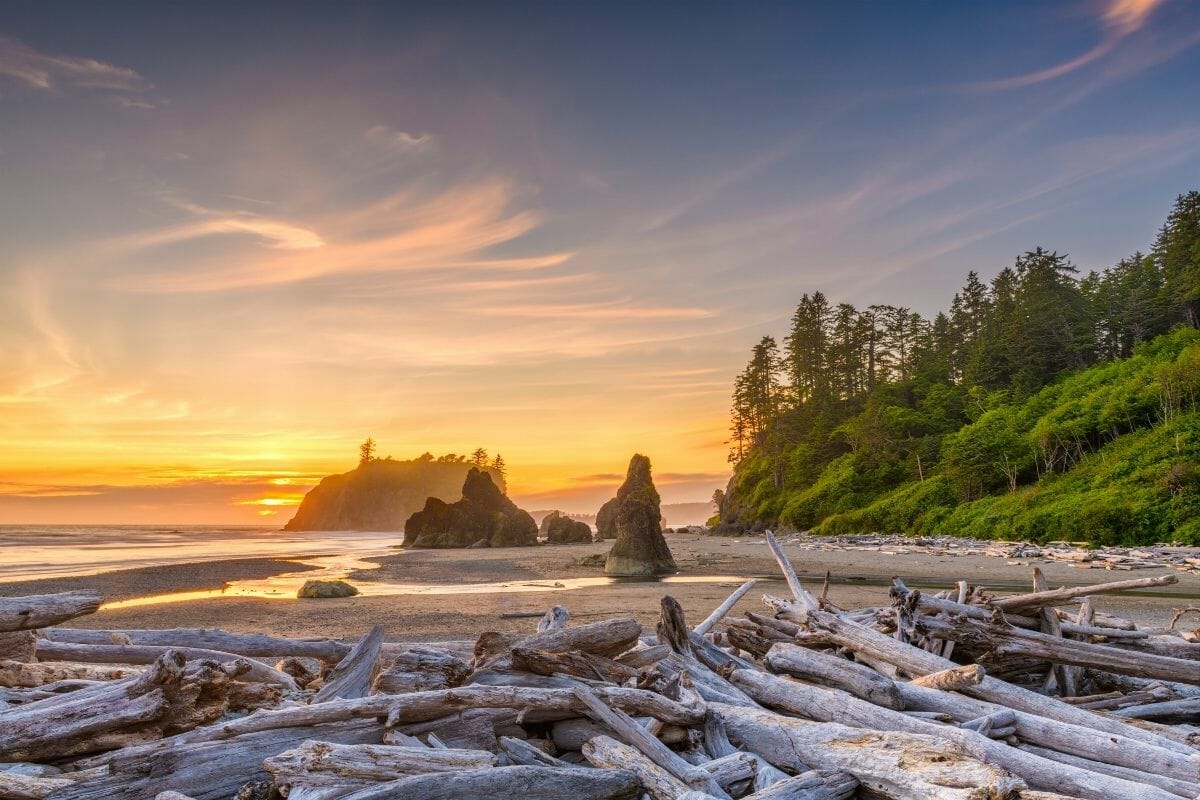
Recommended by Candice from CS Ginger
Entrance fee: $30 per vehicle (valid for 7 days)
Best time to visit: Spring to fall
How many days to spend there: 3-4 days
Highlights: Hoh Rainforest, Hurricane Ridge, Lake Crescent, and Ruby Beach
Where to stay: Sol Duc Hot Springs Resort
One of the most beautiful national parks on the West Coast is Olympic National Park. This national park is located on the peninsula in northern Washington. The park is about two hours from Seattle across the Puget Sound.
The best time to visit Olympic National Park is from spring through the fall. Winter is very cold and rainy. The weather will be warmer into the summer and early fall compared to spring and later in the year. You can expect rainy days no matter when you visit but the summer sees the least amount of rain.
One of the best things to do in the Olympic National Park is to visit the Hoh Rainforest. Because of the high amount of rainfall this part of the coast sees, there is lush vegetation.
The Hoh Rainforest Visitor Center is about 30 miles south of Forks, Washington. There are beautiful mossy trees and beautiful vegetation. The Hall of Mosses is the most popular trail in this area.
A beautiful beach in Olympic National Park is Ruby Beach. It is one of the most well-known beaches and is beautiful at sunset. If you look at the sand, you can see crystals resembling rubies which is how the beach gets its name. Rialto Beach is another beautiful beach in the area.
Sol Duc Hot Springs Resort is a great place to stay in the heart of the Olympic Peninsula. It is a beautiful cabin with hot-springs access and restaurants. It is located in Port Angeles.
13. North Cascades National Park, Washington
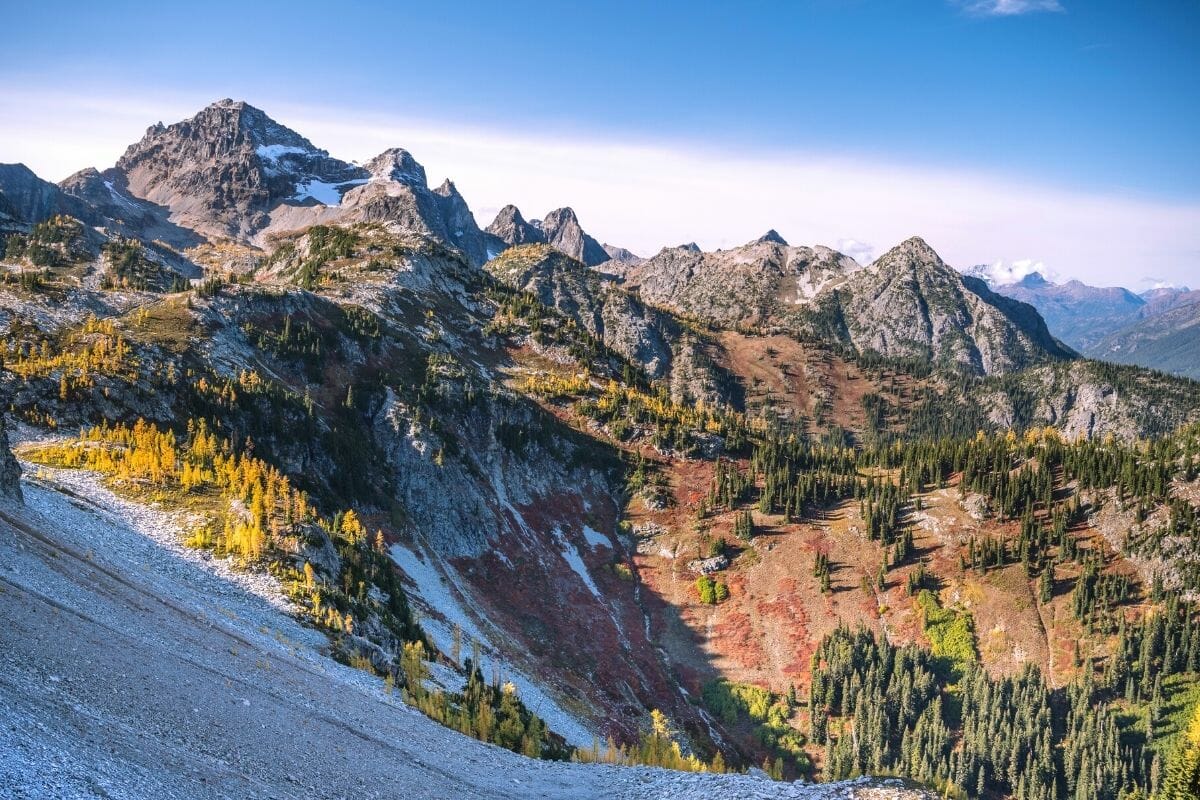
Recommended by Hannah from That Adventurer Blog
Entrance fee: Free
Best time to visit: Late June – September (summer)
How many days: 1 -2 days
Highlights: Diablo Lake, North Cascades Highway
Where to stay: Camp within the park or a hotel in Winthrop or Bellingham
One of the best West Coast National Park is North Cascades National Park, located in Washington State and bordering British Columbia in Canada. It’s about 2.5 hours from both Seattle, WA, and Vancouver, BC.
Sometimes called the “The American Alps”, North Cascades National Park is full of glacial mountain peaks, forested valleys, and emerald green lakes. The mountain range, the Cascades, runs from British Columbia to northern California and it’s believed that these mountains are around 5-6 million years old.
If you love hiking and emerald waters, then the North Cascades is one of the best national parks on the West Coast you need to visit. There’s beauty everywhere you look and plenty of opportunities to spot wildlife such as black bears, marmots, and mountain goats.
One day is usually enough to visit the main viewpoints within the park. One of the highlights of the North Cascades National Park is Diablo Lake. This emerald-green lake at the center of the park can be seen as you drive through, or by taking a short hike on the Thunder Knob Trail.
This is one of the best short and easy trails in the park that’s worth doing even if you’re only visiting for one day. Another of the best things to do is to drive the North Cascades highway; just remember to check it’s open before going as the road closes over winter.
Best National Parks in the Western United States
Leaving the strictly speaking West Coast, there is no shortage of amazing national parks in the western part of the country either. The following section includes the best parks in the western states, such as Montana, Arizona, Nevada, Utah, Colorado, or Wyoming.
14. Glacier National Park, Montana
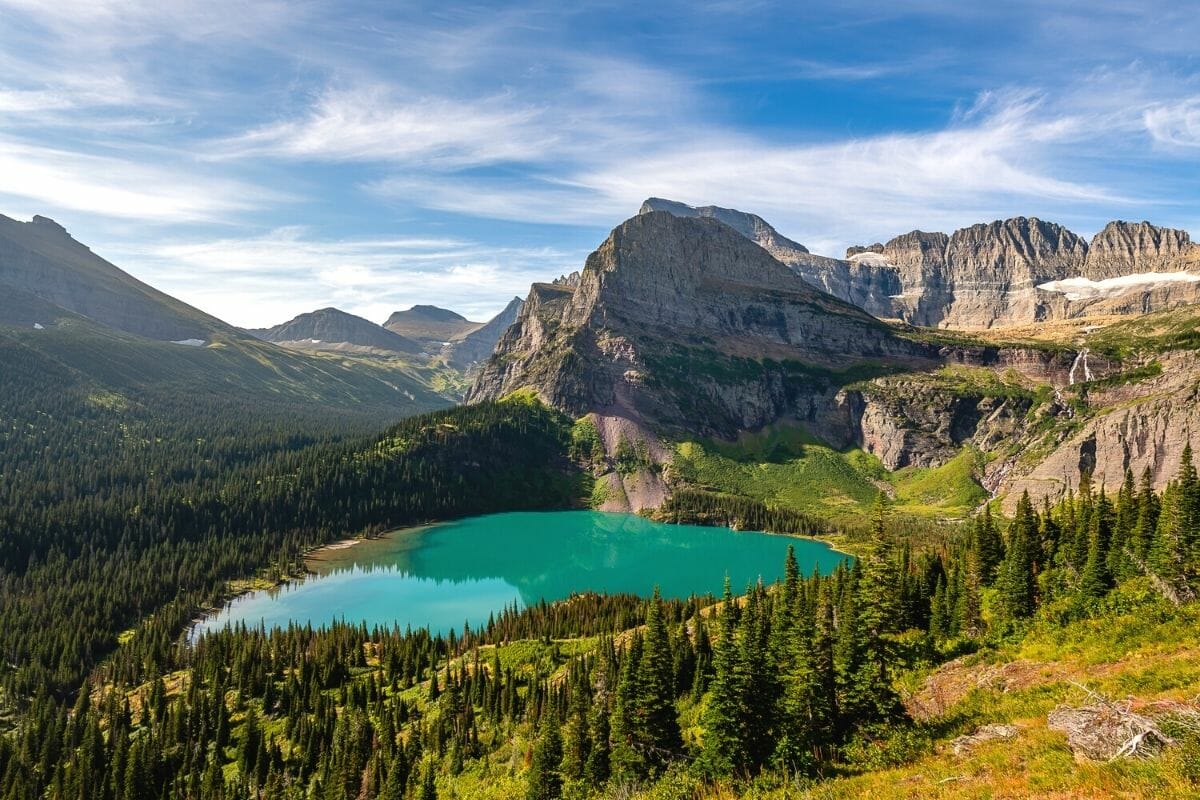
Recommended by Katy from A Rambling Unicorn
Entrance fee: $35 per vehicle (valid for 7 days)
Best time to visit: late June to early October
How many days to spend there: 3-5 days
Highlights: Going-to-the-Sun-Road, Avalanche Lake Trail, Grinnell Glacier, Lake McDonald
Where to stay: In the town of West Glacier or Lake McDonald Lodge
If you’re looking for a spectacular National Park in the Western United States, you can’t beat Glacier National Park in Montana. This stunning wilderness area is known for its alpine beauty, sparkling lakes, and miles of hiking trails.
Located in the Rocky Mountains along the Continental Divide, the park gets its name from the pristine glaciers that used to cover many of its peaks. Unfortunately, few glaciers remain there today. Grinnell Glacier is one of the most well-known remaining glaciers as well as a popular hiking destination.
One of the best ways to explore the area is on foot. The park covers 1 million square acres (4,000 sq km) and includes over 700 miles (1,125 km) of hiking trails. Avalanche Lake Trail is one of the best hikes in the park and leads to a spectacular alpine lake.
Another great way to explore the National Park is by taking a scenic drive. Going-to-the-Sun Road is the only road to traverse the entire park and crosses Logan Pass at an elevation of 6,646 feet (2,025 m). This 50-mile (80 km) scenic wonder is one of Glacier’s most popular attractions and is only open in the summer months.
Be aware that Glacier National Park is in grizzly bear country. You should familiarize yourself with bear safety etiquette and bring along bear spray if you plan to venture into the woods.
15. Grand Canyon National Park, Arizona
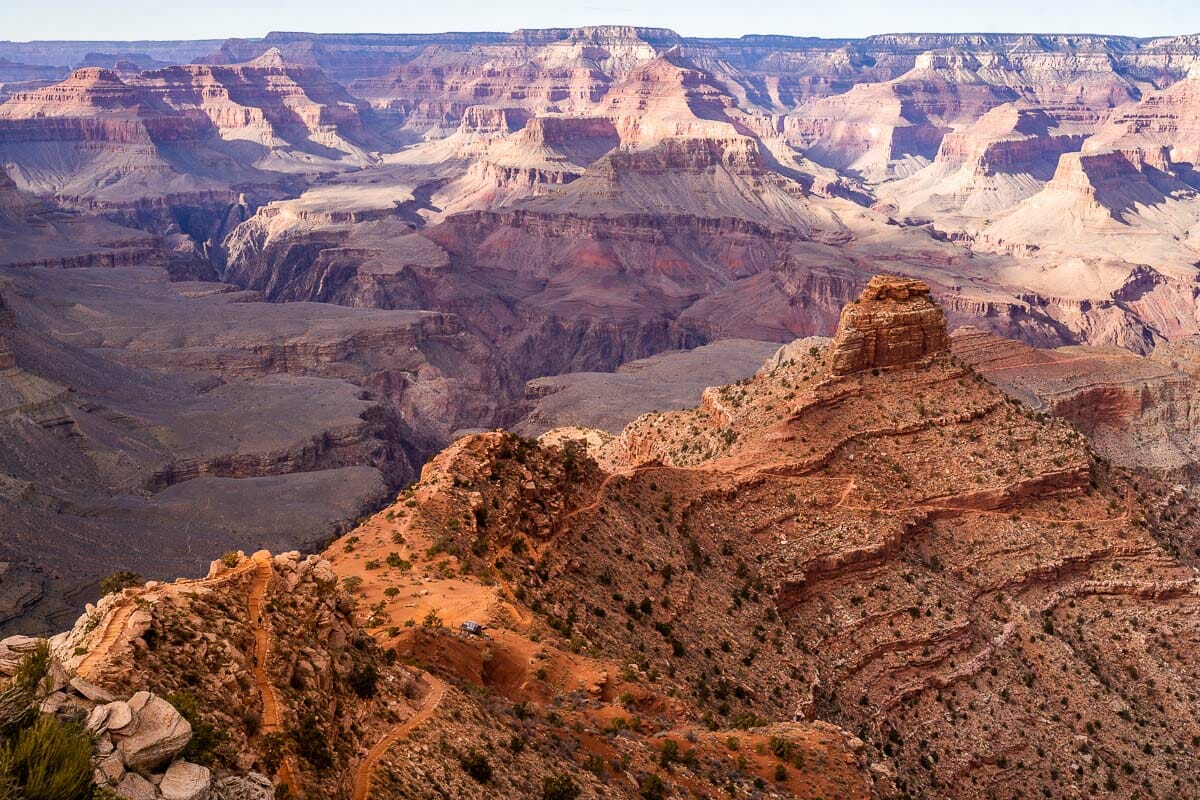
Recommended by Kriszti from She Wanders Abroad
Entrance fee: $35 per vehicle (valid for 7 days, includes both the North Rim and the South Rim)
Best time to visit: Spring and fall
How many days: 2-3 days
Highlights: Grand Canyon, Mather Point, South Kaibab Trail
Where to stay: Camp within the park or a hotel in Tusayan
The Grand Canyon is one of the most visited national parks in the Western United States, and for good reason! It’s one of the must-see destinations in the United States, located in northern Arizona.
It is believed that it was formed around 5/6 million years ago when the Colorado River sliced a channel through the layers of rock. It measures over 270 miles (435 km) in length, 18 miles (29 km) in width, and 1 mile (1.6 km) in depth.
The Grand Canyon actually has 4 different parts that you can visit: the South Rim, Grand Canyon West, Grand Canyon East, and the North Rim. It’s important to note that only the South Rim and the North Rim are part of the Grand Canyon National Park, the other two require different passes.
The Grand Canyon is a popular destination for visitors from all over the world and can be enjoyed by visitors of all ages. The main attractions are found along the South Rim and can easily be seen in just a few days.
Mather Point is the most popular viewpoint in the park and offers great views of the canyon. You also can’t miss Bright Angel Trail which leads down into the canyon.
Other popular trails include South Kaibab Trail and North Kaibab Trail. If you have time, be sure to hike to the bottom of the canyon and back. It’s an incredible experience that you won’t soon forget but be prepared for a very strenuous hike.
Alternatively, you can hike only one part of the trail. Hiking to Ooh Aah Point is one of the best options, which is a relatively easy, 1.8-mile long trail that is part of the South Kaibab Trail.
16. Petrified Forest National Park, Arizona
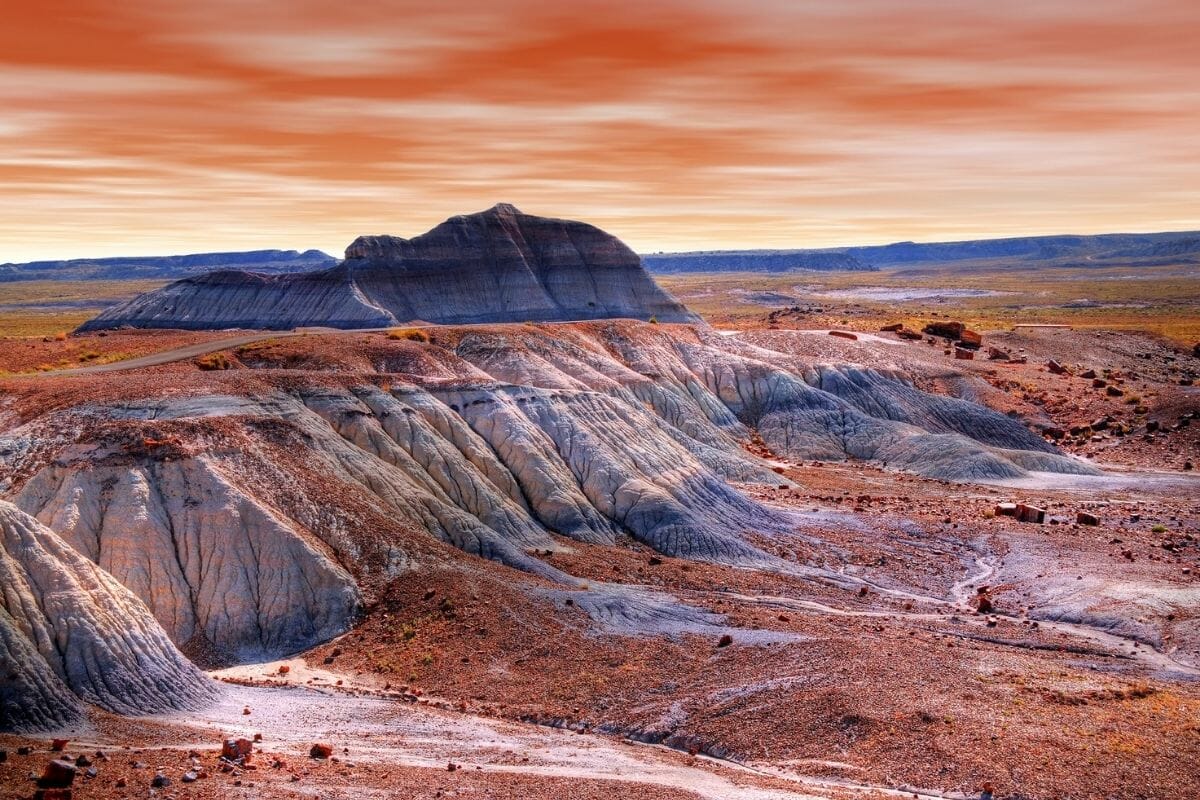
Recommended by Sam from My Flying Leap
Entrance fee: $20 per vehicle (valid for seven days)
Best time to visit: Spring or fall
How many days to spend: 1 day
Highlights: Forest of fossilized trees and ruggedly beautiful badlands
Where to stay: In the nearby town of Holbrook
Petrified Forest National Park is located in Holbrook in northern Arizona. The park is known for its fossilized trees, created over 225 million years ago. There are a number of short paths where you can walk among the fallen, fossilized trees. This is a unique area unlike any in the world.
You’re allowed to touch the fossils, but you’re not permitted to leave the park with any. If you do want to take home a souvenir, no worries! There are local shops that sell them near the park entrance.
The park also includes the Painted Desert, a desolate area of badlands created by millions of years of erosion. During the day, the colors of this part of the part are fairly subtle, but at sunrise and sunset, they are quite stunning.
You’ll find some Native American ruins and petroglyphs in the Painted Desert area, and there’s a ruin called the Agate House pueblo near the fossilized trees as well. If you’re interested in learning more about the area and the people who once lived there, head to the visitor centers.
Fall and spring are popular times to visit. It gets quite cold and snowy in the winter, and in the summer, it’s hot and there’s limited shade. If you do go during the summer, be sure to bring plenty of water and sunscreen.
There are no accommodations in the park, but you can stay in Holbrook. There are a number of options 20 minutes away including the Best Western Arizonian and Lexington Inn Holbrook. There are also RV parks, including the OK RV Park and the Petrified Forest KOA.
17. Great Basin National Park, Nevada
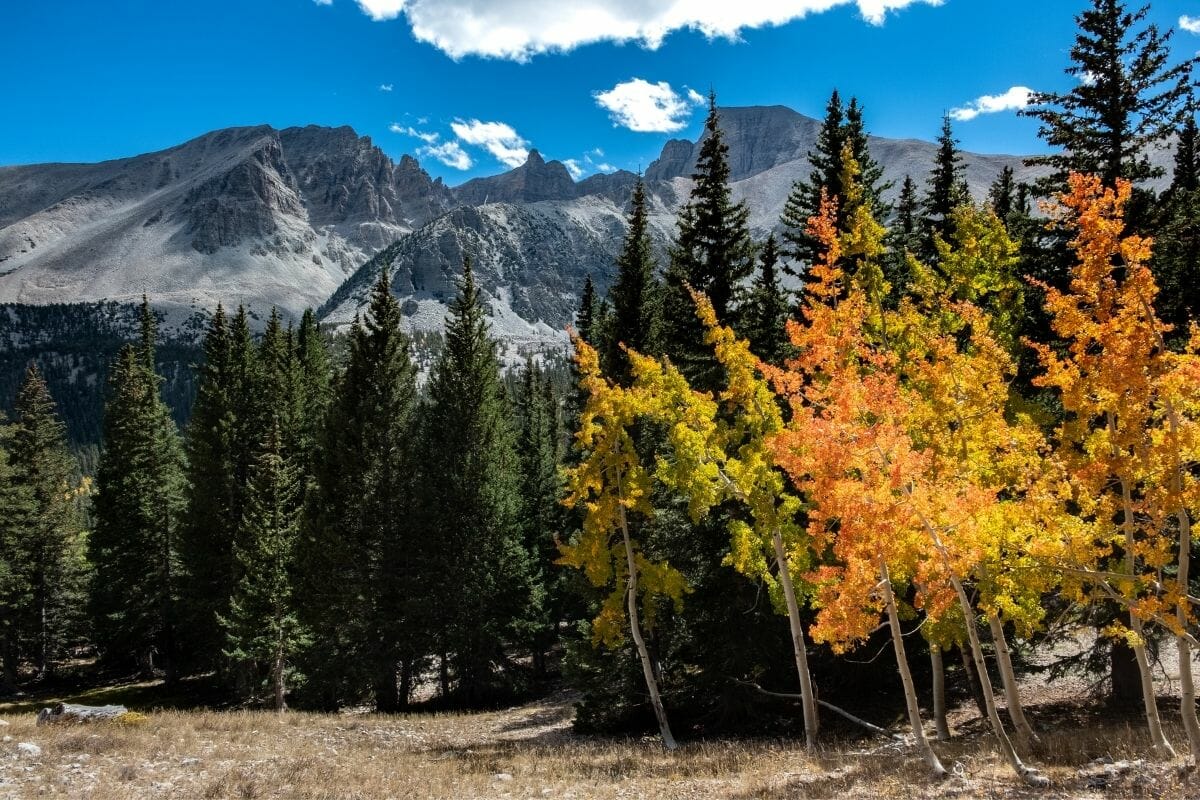
Recommended by Nicole from SW National Parks
Entrance fee: No entrance fee
Best time to visit: Spring and summer
How many days to spend there: 1-2 days
Highlights: Alpine Lakes Loop Trail, Lehman Cave Tours, Bristlecone Trail
Where to stay: Hidden Canyon Retreat is a great place to stay just 6 miles from the park
Located in Nevada, a bit out of the way of other parks, Great Basin is one of the most underrated national parks in the west. Most people only spend a day at Great Basin but to really get a feel for the park, it’s best to spend two days there and do a few hikes.
Great Basin is one of the few national parks that does not charge an entrance fee. The park is home to trees that are over 4,000 years old, so doing a hike to see the bristlecone trees which are famous in the area is a must. One of the best trails to follow is the Bristlecone Trail, which is a 3-mile long, relatively easy hike.
Great Basin is also a great location for stargazing as there is no light pollution near the park. Some of the best places to marvel at the beautiful night sky are Mather Overlook on the Wheeler Peak Scenic Drive and Baker Archaeological Site.
For those who would like to take in the scenic views, you can drive the Wheeler Peak Scenic Drive which climbs over 3,000 feet up the mountain for amazing views.
18. Zion National Park, Utah
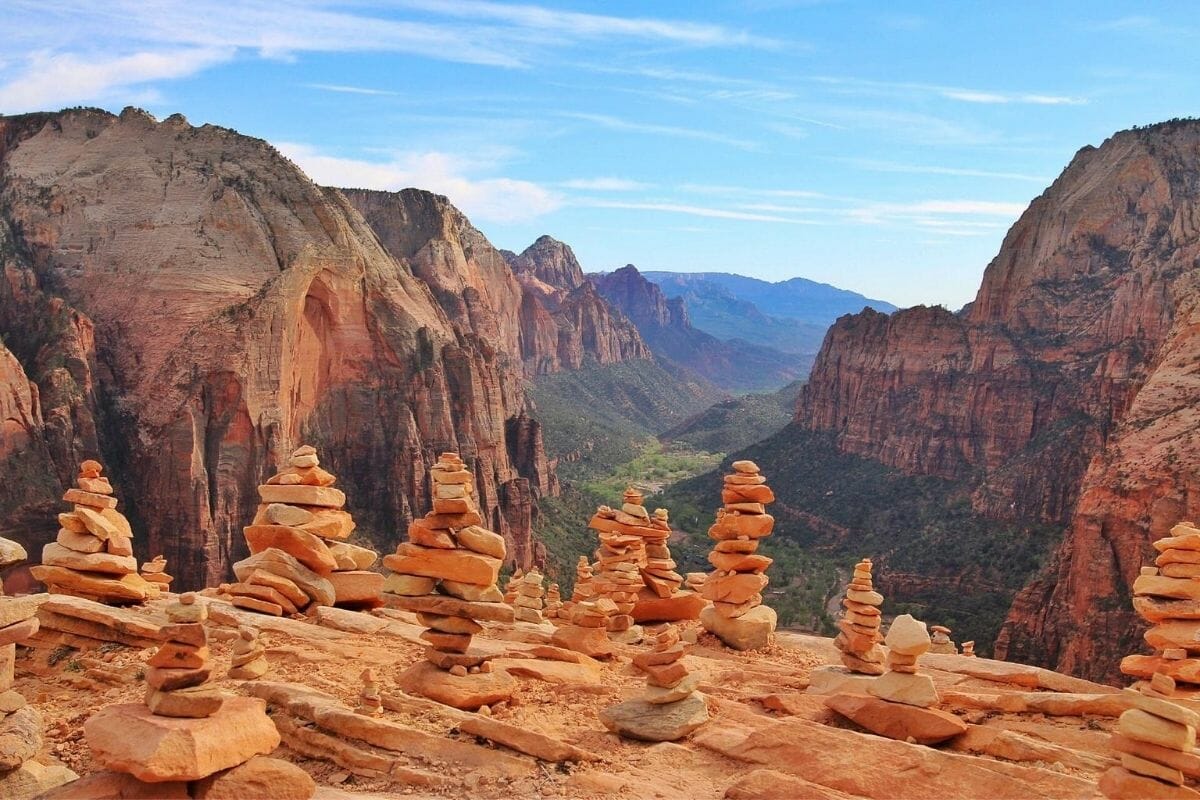
Recommended by Stephanie from The Unknown Enthusiast
Entrance fee: $35 per vehicle (valid for 7 days)
Best time to visit: Fall, Winter, or Spring, when the heat isn’t so intense
How many days to spend there: 2-4 days
Highlights: Angel’s Landing and The Narrows hikes
Where to stay: Springdale, Utah – Hampton Inn and Suites is a good hotel option there.
Zion National Park is located in the southwest region of Utah. There are many absolutely stunning hikes and vistas in this popular national park that is full of red rocks and unique trails.
Angel’s Landing is ostensibly one of the best hikes in Zion, as the final 0.5 miles to the summit is along a very narrow, steep path with sheer dropoffs – there are chains to hang onto for safety as you climb! At the top, you can enjoy 360-degree views over the canyon.
Note that starting in April 2022, permits are required to hike Angel’s Landing. You can either enter the lottery to get a permit several months ahead of time, or you can enter the last-minute lottery for a permit the day before.
The Narrows, a hike in a slot canyon stream, is another popular hike with epic views and an epic experience as you hike in the river itself. And Canyon Overlook is a shorter, easier hike that still delivers stunning viewpoints.
Because Zion is one of the most popular national parks on the west, it can get crowded, but visiting in winter can be a great way to escape the crowds with (generally) mild weather.
19. Bryce Canyon National Park, Utah
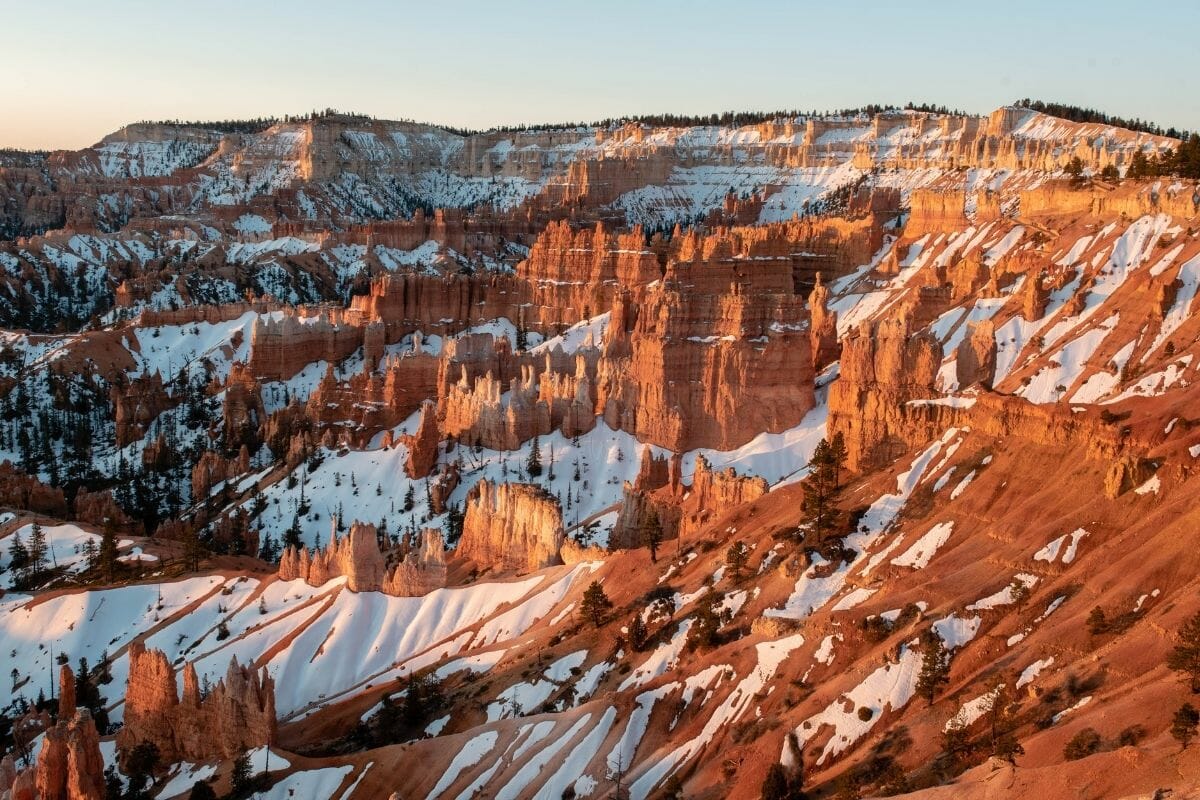
Recommended by Val from Voyages with Val
Entrance fee: $35 per vehicle (valid for 7 days)
Best time to visit: Spring and fall
How many days to spend there: 1 to 3 days
Highlights: Navajo and Queens Garden Loop Trail, Scenic Drive
Where to stay: In the park campgrounds or Bryce Canyon Lodge
Bryce National Park is one of the most unique National Parks in the Western United States. The orange and red hoodoos stick up out of the canyon walls making a stunning display to view or hike through.
You can spend several days in Bryce, but if you are limited on time you can see the highlights with just one day in Bryce Canyon.
Hiking is one of the best things to do in Bryce. Two of the best hikes are the Navajo and Queens Garden Loop and Peekaboo Loop trails.
If you don’t want to hike you can also view the canyon from several viewpoints in the canyon. Sunrise and Sunset Point are two of the best viewpoints located near Bryce Lodge.
Drive down the entire 18 miles long Bryce Scenic Drive to see all of the viewpoints in the National Park, ending at Rainbow Viewpoint. You can also rent a bike, and bike to the viewpoints on the drive.
End your day in Bryce by stargazing in the park. Bryce is an International Dark Sky Park and one of the best places in the world to view the night sky and thousands of stars!
20. Capitol Reef National Park, Utah
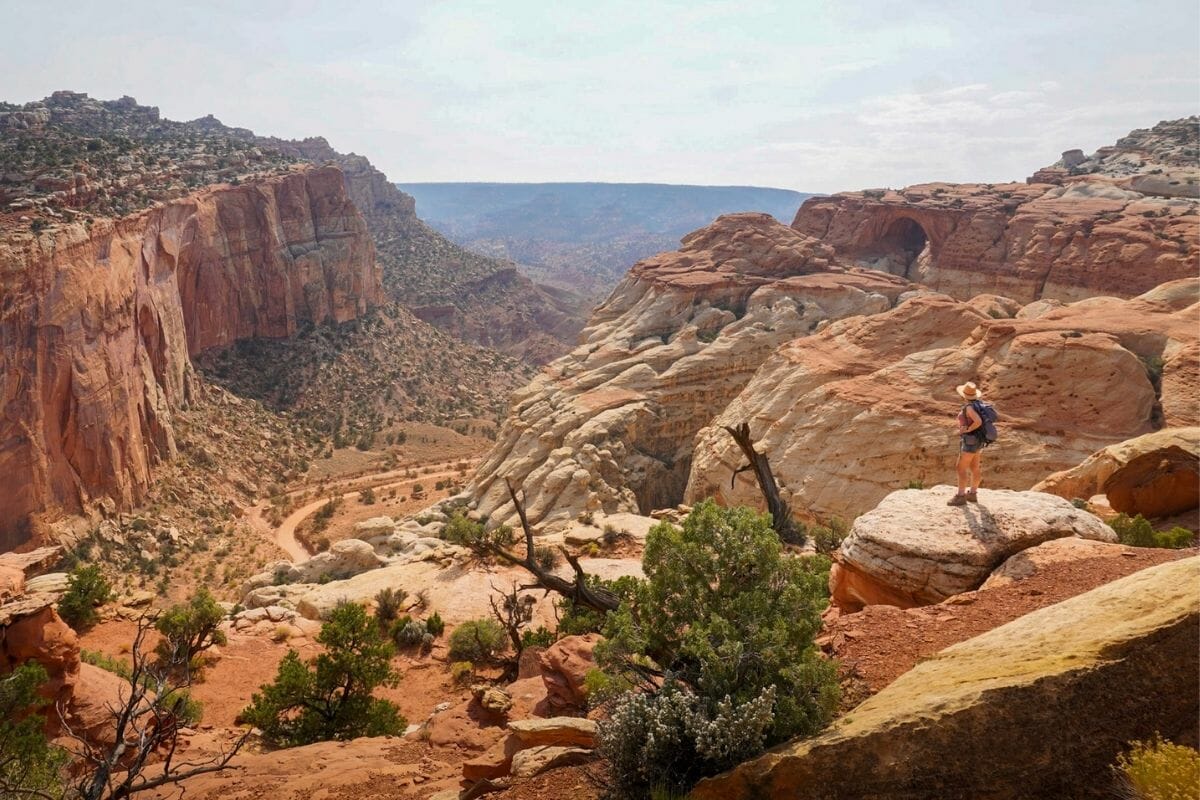
Recommended by Jessica from Uprooter Traveler
Entrance fee: $20 per vehicle (valid for 7 days)
Best time to visit: March through April or September through October
How many days to spend there: 2-3 days
Highlights: Cassidy Arch, Cathedral Valley, Fruita
Where to stay: In the neighboring town of Torrey, Utah
Capitol Reef, located in southern Utah, may be the state’s least-visited national park, but it’s nevertheless just as beautiful as the other Mighty Five.
Thanks to its location along a water pocket fold (i.e., basically a giant wrinkle in the Earth’s crust) that stretches for 100 miles, colorful rock formations, called “reefs”, have been formed over millennia of erosion and now jut dramatically out of the desert.
You can explore these amazing features on foot, like along the Hickman Bridge Trail to a 300-foot tall natural bridge or to Cottonwood Wash, a beautiful slot canyon. You also can’t miss hiking to Cassidy Arch, one of the only natural arches in Utah that you can walk on top of.
Alternatively, there’s a variety of low-impact activities to enjoy, from its Scenic Drive, passing the park’s most vibrant rock formations, to exploring the 1800s settlement of Fruita (which even offers pick-your-own-fruit orchards in season!) and, given the park’s status as an International Dark Sky Park, taking in the incredible night skies.
While most of the roads around Fruita (where the majority of the park’s main attractions are located) are well-maintained, some of the other areas of the park have pretty serious wash boarding. So if you’re planning on exploring the entirety of the park’s 378 square mile footprint, consider bringing along a high-clearance, 4WD car.
Capitol Reef offers one developed campground and two primitive ones, with no lodges in the park itself. Alternatively, you can find plenty of hotels in the neighboring town of Torrey, Utah.
21. Canyonlands National Park, Utah
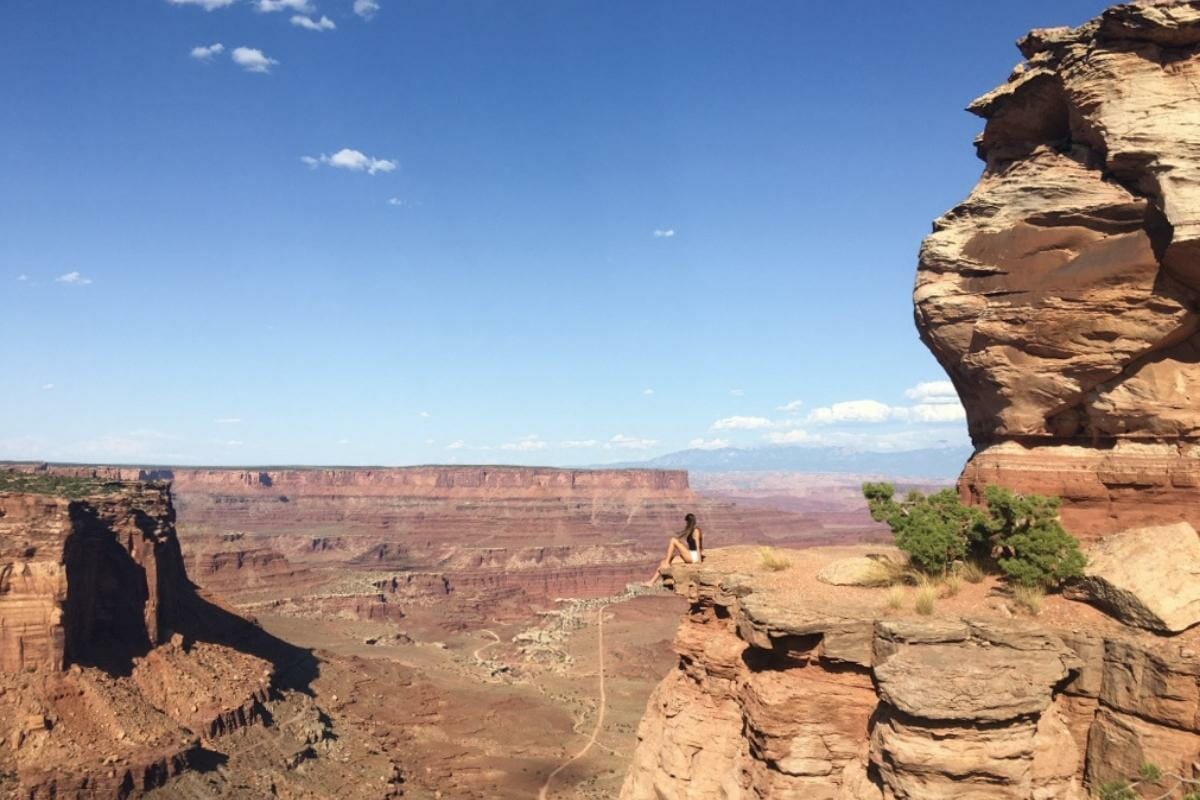
Recommended by Ashley Jansen of Jetset Jansen
Entrance fee: $30 per vehicle (valid for 7 days)
Best time to visit: Spring or fall when the temperatures are a little cooler
How many days to spend there: 1-3 days
Highlights: Mesa Arch, Grandview Point, Shafer Canyon Overlook
Where to stay: Moab, Utah
Located in the southeast corner of Utah, Canyonlands National Park is one of the best national parks in the Western United States you shouldn’t miss. Moab, Utah is a great base to have when exploring the area, as Canyonlands and Arches National Park are both in close proximity.
Canyonlands is a large national park, covering over 330,000 acres with incredibly unique terrain. For whatever reason, it comes in as Utah’s least-visited national park but if you love the wild west landscape, Canyonlands definitely can’t be missed.
There are 4 districts to explore throughout the park: Island in the Sky, the Needles, the Maze, and the Rivers.
Island in the Sky is the most accessible section and the closest to Moab. It has easy-to-visit viewpoints with jaw-dropping canyons and overlooks. You can spend the day driving to each viewpoint and doing short hikes to explore this section.
To explore the other districts, you’ll need proper preparations and likely either a 4×4 or a guide. These sections are more off the grid and will be an adventure to explore but don’t let that deter you from adding Canyonlands to your list of the best national parks in the west.
Island in the Sky alone, is a beautiful section. The Mesa Arch at sunrise is a popular spot for photographers and you can’t miss the overlooks at Shafer Canyon and Grandview Point to get some truly amazing views.
22. Arches National Park, Utah
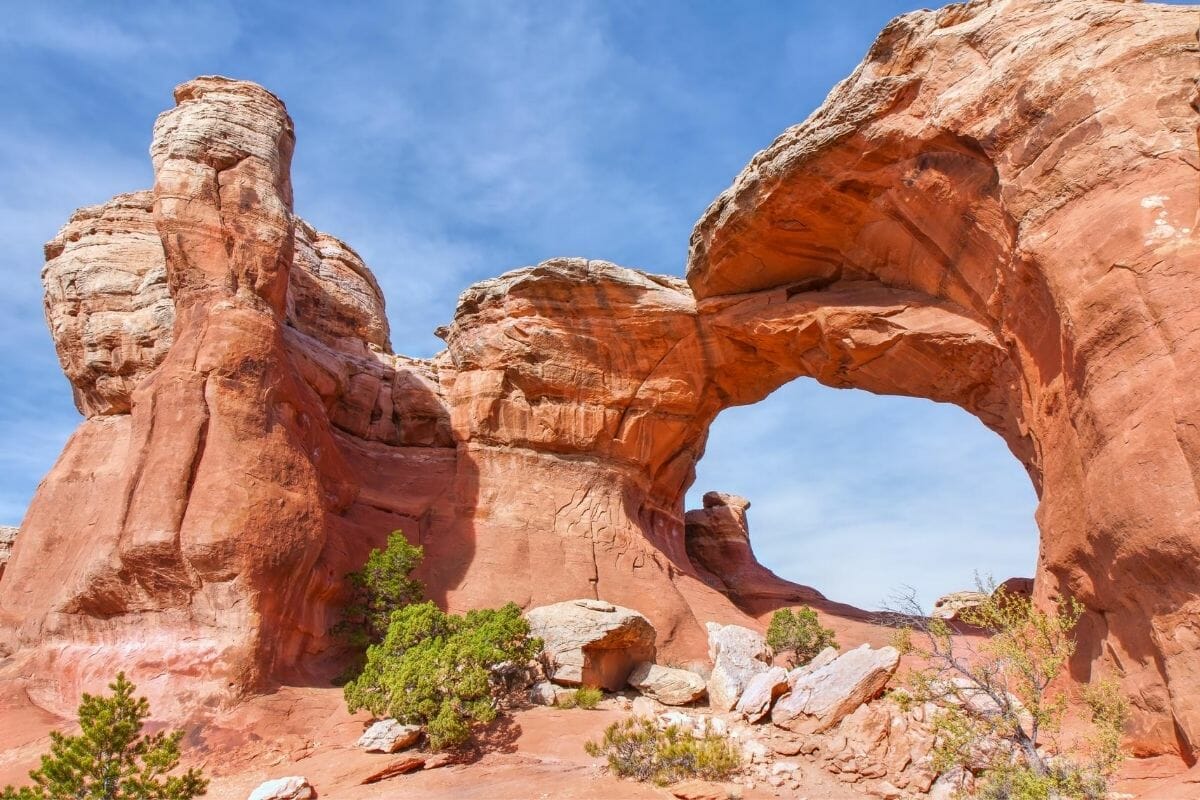
Recommended by Melissa from Parenthood and Passports
Entrance fee: $30 per vehicle (valid for 7 days)
Best time to visit: Fall
How much time to spend there: 2 days
Highlights: Delicate Arch, Double Arches, Landscape Arch
Where to stay: Springhill Suites by Marriott – Moab, Utah
Arches National Park in northeastern Utah is one of the most iconic national parks in the Western United States. Its unique topography of more than 2,000 natural red rock, sandstone arches gives this park its name.
Spanning more than 76,000 acres, this park just outside of Moab, Utah is home to one of the most famous natural landmarks in the United States, Delicate Arch. Delicate Arch is a 52-foot tall natural arch set on the edge of a canyon.
The 3-mile in-and-out trail to get to the arch is the most popular hike in the national park. Although it is considered a moderately difficult hike, the views are well worth the effort and challenge to get there.
For easier hikes that offer jaw-dropping views with minimal effort, Double Arches Trail and The Windows are situated just off the main road through the park and require very little hiking. These trails are easy hikes you can do in Arches National Park with kids.
Insider tip: Arches National Park has a desert climate with harsh sun and limited shade. Temperatures, particularly in the summer months can be extreme. Bring plenty of water and sunscreen and wear protective clothing when hiking in the park to avoid dangerous dehydration and overheating.
23. Mesa Verde National Park, Colorado
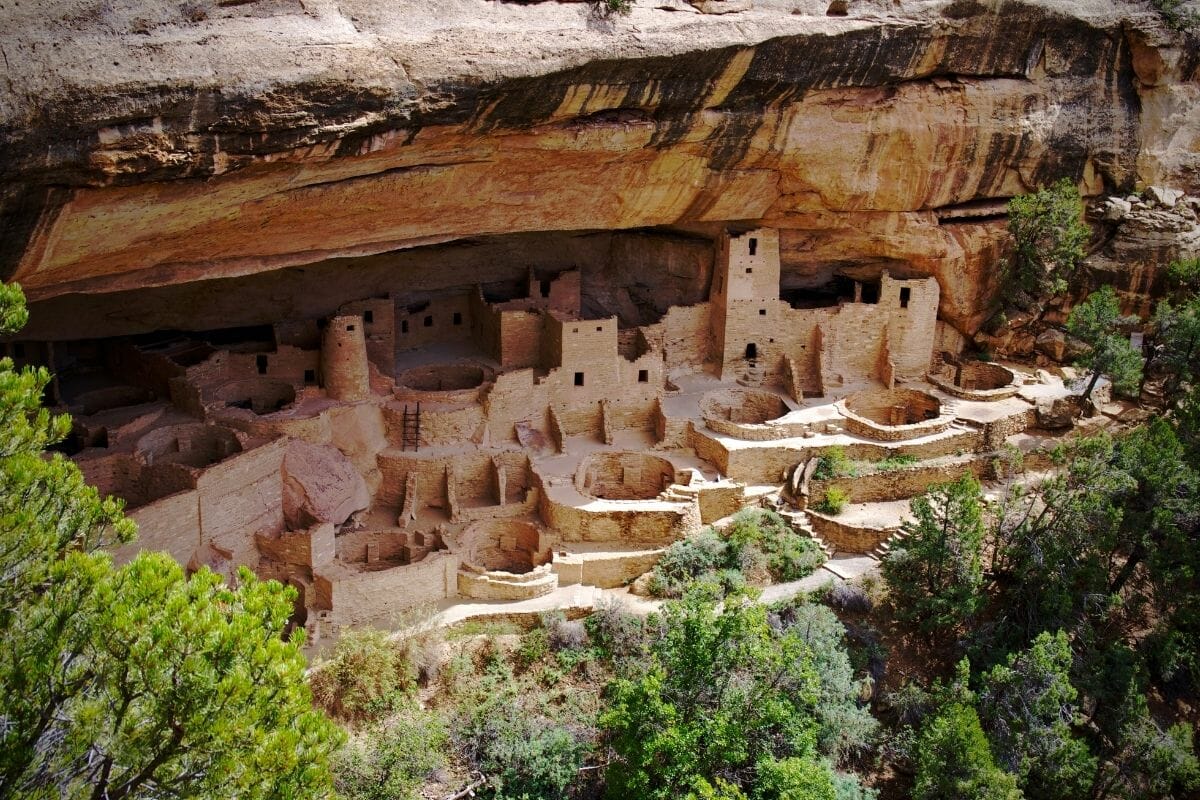
Recommended by Patricia from Ze Wandering Frogs
Entrance fee: $20-$30 per vehicle (prices vary depending on the season, passes valid for 7 days)
Best time to visit: Spring and fall
How many days to spend there: 1-2 days
Highlights: Cliff Palace, Mesa Top Loop Road, Sun Point Overlook
Where to stay: Far View Lodge, 15 miles from the park, and the Morefield Campground, 4 miles away.
Mesa Verde National Park is a must-see in southwest Colorado, as it is home to some of the most incredible Ancestral Puebloan cliff dwellings.
Cliff Palace is one of the better-preserved dwellings and one of the largest. You probably won’t visit all of the 600 houses, but make sure to see Cliff Palace but also descend into one of the kivas, explore the Wetherill Mesa Long House, and admire the Balcony House.
The park provides ranger-guided tours that will give you a better understanding of Native American history, as they give you a glimpse of how Ancestral Pueblo lived in Mesa Verde from AD 600 to 1300.
Driving is the best way to explore the park, as the Mesa Top Loop Road passes by different archaeological sites as well as overlooks. Don’t miss the stunning views from the Sun Point Overlook!
Note that the drive up to the park is long, windy, and narrow, and driving from the park entrance to the further sites takes about 1.5 hours in itself. So be prepared for a long day on the road.
24. Grand Teton National Park, Wyoming
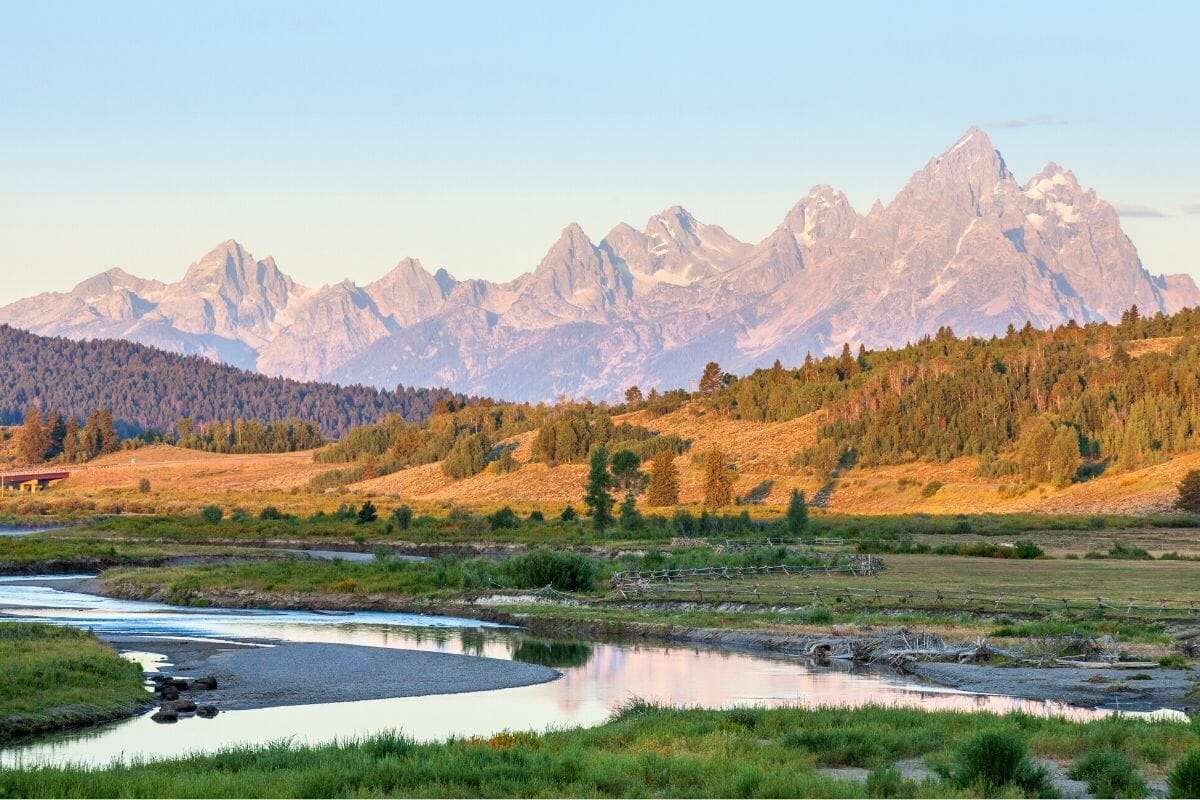
Recommended by James from Parks Collecting
Entrance fee: $35 per vehicle (valid for 7 days)
Best time to visit: Late June and September
How many days to spend there: 3 days
Highlights: Moulton Barns at historic Mormon Row, views of the Teton Range, Jenny Lake, Cascade Canyon hike, Jackson Lake
Where to stay: The Hotel Jackson in Jackson (the nearest gateway town) or Jenny Lake Lodge inside the park
Grand Teton National Park is centered around the Teton Range – a dramatic spine of craggy peaks rising straight up out of the plains.
At the base of the mountains are a string of alpine lakes, and the aptly-named Snake River winds in front of the lakes. The national park is located in northwest Wyoming, just south of Yellowstone National Park.
No Grand Teton itinerary is complete without driving the 42-mile scenic loop drive, stopping off at breathtaking viewpoints along the way.
Highlights include Jenny Lake Overlook; the views of Jackson Lake from the top of Signal Mountain; the famous views of the historic Moulton Barns with the mountains in the background; the iconic Oxbow Bend and Snake River Overlook; and the lovely Schwabacher’s Landing.
In addition to the stunning scenery, there is plenty to do inside the park. The area is prime territory for moose in summer and elk in winter. You can also hit the trails and hike to some of the lakes like Taggart Lake or trek into the canyons between the peaks, like Cascade Canyon.
If you like being out on the water, you can rent a boat or canoe and paddle around Jackson Lake; take a short scenic cruise on Jenny Lake; or float down Snake River, soaking in the views along the way.
The best time for photography is in the morning or for sunset, so it’s worth getting up early! This is also the best time to see moose and black bears.
25. Yellowstone National Park, Wyoming
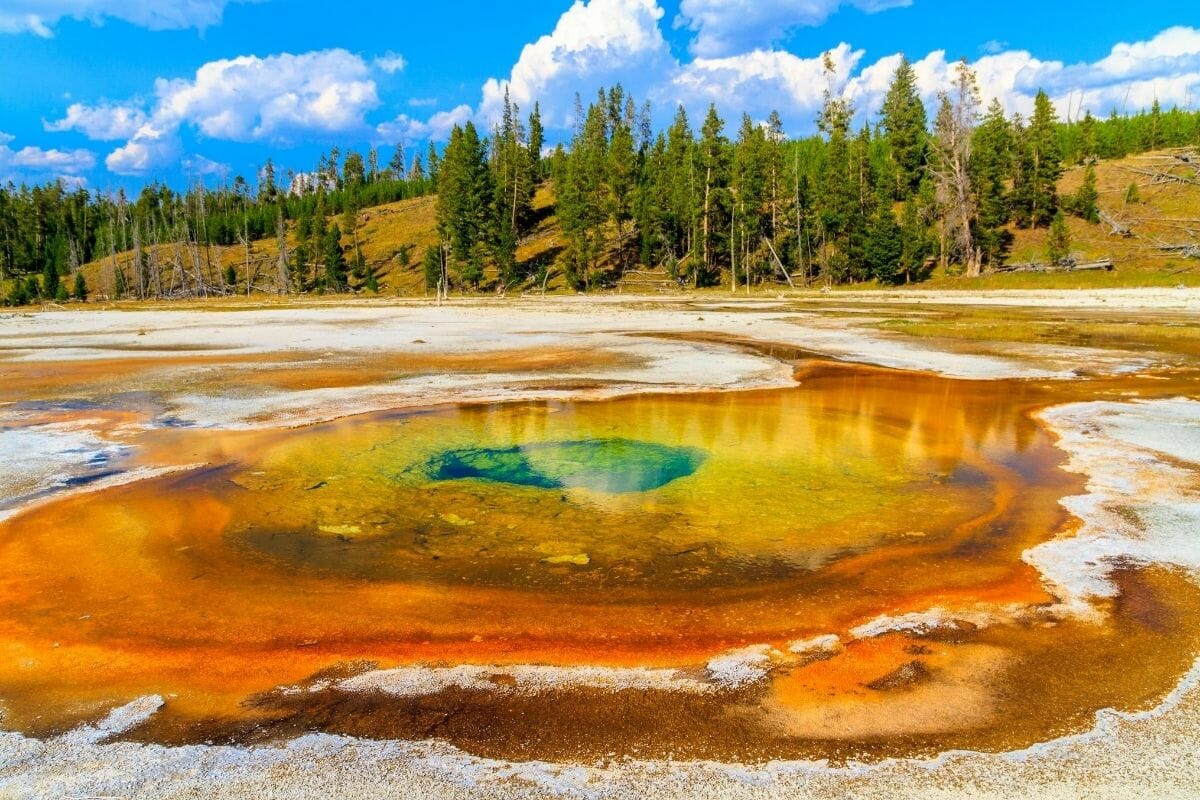
Recommended by Sam from Find Love & Travel
Entrance fee: $35 per vehicle (valid for 7 days)
Best time to visit: June to August
How much time to spend there: 2-3 days
Highlights: Old Faithful, Grand Prismatic Springs, and Yellowstone’s Grand Canyon
Where to stay: Stay inside the park at one of the 9 lodges or in West Yellowstone, outside of the entrance.
Yellowstone National Park is easily one of the best national parks to visit on the West Coast. This massive park stretches between Wyoming, Montana, and Idaho and is the first National Park in the United States.
This national park offers an abundance of wildlife including grizzly bears, American buffalo, wolves, elk, and deer to name a few. Furthermore, the park is unique in the fact it has a wide array of thermal features – Yellowstone is known as a supervolcano, after all.
Some of the top attractions in Yellowstone are geysers, mud pots, and spring that you can all experience during your visit. The park also has a handful of waterfalls, excellent hiking trails, and a ton of backcountry for those looking to get off the grid.
Yellowstone is located at higher altitudes so even in the summer it can be cold during the morning and night so make sure to bring some warmer layers.
Map of the Best West Coast National Parks
On the below map you can see all the West Coast national parks mentioned in this article with their retrospective number. The numbers don’t reflect any ranking order, they are just simply there to make it easier for you to find all the best national parks on the West Coast on the map!
You can also save this map to your Google Maps app on your phone if you click on the bracket in the upper right corner. Super convenient, right?
Pin It for Later!
